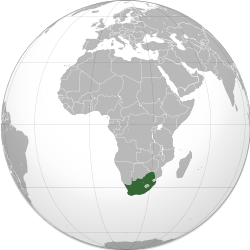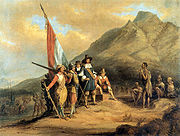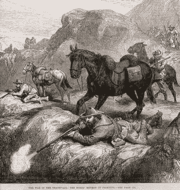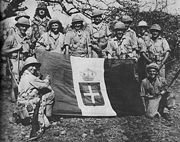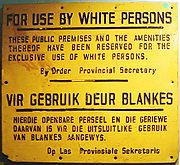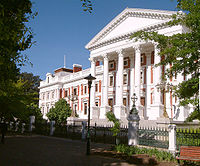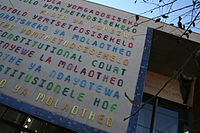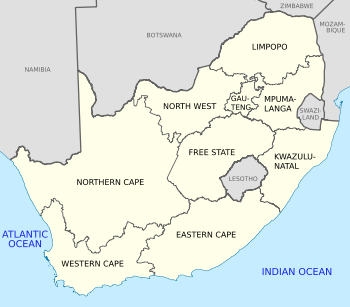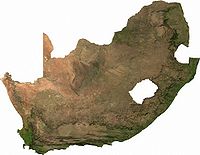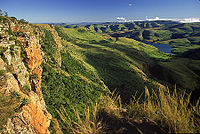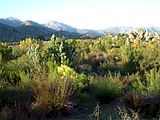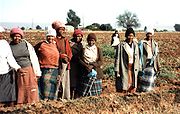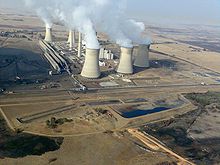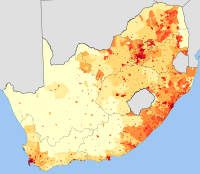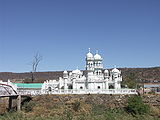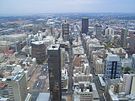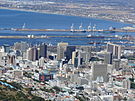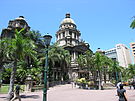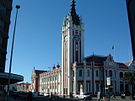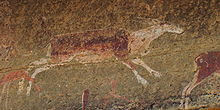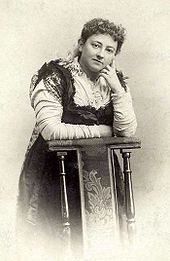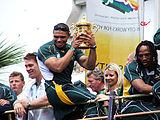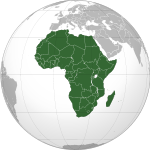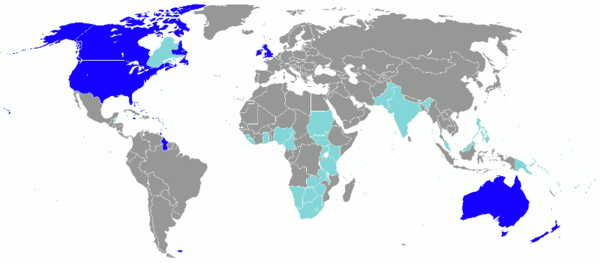- South Africa
-
This article is about the modern country. For other uses, see South Africa (disambiguation).
Republic of South Africa
Republiek van Suid-Afrika (Afrikaans) -
iRiphabliki yeSewula Afrika (S. Ndebele) -
iRiphabliki yomZantsi Afrika (Xhosa) -
iRiphabhuliki yaseNingizimu Afrika (Zulu) -
iRiphabhulikhi yeNingizimu Afrika (Swazi) -
Repabliki ya Afrika-Borwa (N. Sotho) -
Rephaboliki ya Afrika Borwa (S. Sotho) -
Rephaboliki ya Aforika Borwa (Tswana) -
Riphabliki ra Afrika Dzonga (Tsonga) -
Riphabuḽiki ya Afurika Tshipembe (Venda) -
(all 11 names are official)[1]


Flag Coat of arms Motto: !ke e: ǀxarra ǁke (ǀXam)
"Unity In Diversity"Anthem: National anthem of South Africa Capital Pretoria (executive)
Bloemfontein (judicial)
Cape Town (legislative)Largest Johannesburg (2006)[2] Official language(s) Ethnic groups 79.5% Black
9.0% White
9.0% Coloured
2.5% Asian[4]Demonym South African Government Constitutional parliamentary republic - President Jacob Zuma - Deputy President Kgalema Motlanthe - NCOP Chairman M. J. Mahlangu - National Assembly Speaker Max Sisulu - Chief Justice Mogoeng Mogoeng Legislature Parliament - Upper House National Council of Provinces - Lower House National Assembly Independence from the United Kingdom - Union 31 May 1910 - Statute of Westminster 11 December 1931 - Republic 31 May 1961 Area - Total 1,221,037 km2 (25th)
471,443 sq mi- Water (%) Negligible Population - 2011 estimate 50,586,757[4] (24th) - 2001 census 44,819,778[5] - Density 41.4/km2 (169th)
107.2/sq miGDP (PPP) 2011 estimate - Total $555.340 billion[6] - Per capita $10,977[6] GDP (nominal) 2011 estimate - Total $422.037 billion[6] - Per capita $8,342[6] (104th) Gini (2006) 67.4[7] (very high) (2nd) HDI (2009) 0.683  (medium) (129th)
(medium) (129th)Currency Rand ( ZAR)Time zone SAST (UTC+2) Drives on the left ISO 3166 code ZA Internet TLD .za Calling code +27 Coordinates: 30°S 25°E / 30°S 25°E
The Republic of South Africa (also referred to as South Africa, SA or RSA) is a country in southern Africa. Located at the southern tip of Africa, it is divided into nine provinces, with 2,798 kilometres (1,739 mi) of coastline[8][9] on the Atlantic and Indian oceans.[10] To the north of the country lie the neighbouring territories of Namibia, Botswana and Zimbabwe; to the east are Mozambique and Swaziland; while Lesotho is an enclave surrounded by South African territory.[11]
South Africa is multi-ethnic and has diverse cultures and languages. Eleven official languages are recognised in the constitution.[10] Two of these languages are of European origin: Afrikaans, a language which originated mainly from Dutch that is spoken by the majority of white and Coloured South Africans, and South African English. Though English is commonly used in public and commercial life, it is only the fifth most-spoken home language.[10] All ethnic and language groups have political representation in the country's constitutional democracy comprising a parliamentary republic; unlike most parliamentary republics, the positions of head of state and head of government are merged in a parliament-dependent President.
About 79.5% of the South African population is of black African ancestry,[4] divided among a variety of ethnic groups speaking different Bantu languages, nine of which have official status.[10] South Africa also contains the largest communities of European, Asian, and racially mixed ancestry in Africa.
South Africa is ranked as an upper-middle income economy by the World Bank, one of only four countries in Africa in this category (the others being Botswana, Gabon and Mauritius).[12] It has the largest economy in Africa, and the 28th-largest in the world.[13] About a quarter of the population is unemployed[14] and lives on less than US $1.25 a day.[15]
Contents
History
Main article: History of South AfricaPrehistoric
South Africa contains some of the oldest archaeological and human fossil sites in the world.[16][17][18] Extensive fossil remains have been recovered from a series of caves in Gauteng Province. The area is a UNESCO World Heritage site and has been termed the Cradle of Humankind. The sites include Sterkfontein, one of the richest hominin fossil sites in the world. Other sites include Swartkrans, Gondolin Cave Kromdraai, Coopers Cave and Malapa. The first hominin fossil discovered in Africa, the Taung Child was found near Taung in 1924. Further hominin remains have been recovered from the sites of Makapansgat in Northern Province, Cornelia and Florisbad in the Free State, Border Cave in KwaZulu-Natal, Klasies River Mouth in eastern Cape and Pinnacle Point, Elandsfontein and Die Kelders Cave in Western Cape. These sites suggest that various hominin species existed in South Africa from about three million years ago starting with Australopithecus africanus.[19] These were succeeded by various species, including Australopithecus sediba, Homo ergaster, Homo erectus, Homo rhodesiensis, Homo helmei and modern humans, Homo sapiens.
History of
South AfricaMrs. Ples, a 2.05 million year old Australopithecus africanus skull from the Sterkfontein Cave Cradle of HumankindMapungubwe Hill, the site of the ancient capital of the Kingdom of MapungubweThe arrival of Jan van Riebeeck, the first European to settle in South Africa, with Devil's Peak in the backgroundSettlements of Bantu-speaking peoples, who were iron-using agriculturists and herdsmen, were already present south of the Limpopo River (now the northern border with Botswana and Zimbabwe) by the fourth or fifth century CE. (See Bantu expansion.) They displaced, conquered and absorbed the original Khoisan speakers, the Khoikhoi and San peoples. The Bantu slowly moved south. The earliest ironworks in modern-day KwaZulu-Natal Province are believed to date from around 1050. The southernmost group was the Xhosa people, whose language incorporates certain linguistic traits from the earlier Khoisan people. The Xhosa reached the Great Fish River, in today's Eastern Cape Province. As they migrated, these larger Iron Age populations displaced or assimilated earlier peoples, who often had hunter-gatherer societies[citation needed].
Modern humans have inhabited Southern Africa for at least 170,000 years. At the time of European contact, the dominant indigenous peoples were Bantu-speaking peoples who had migrated from other parts of Africa about one thousand years before. The two major historic groups were the Xhosa and Zulu peoples.
Historical states
in present-day
South Africa
before 1600 Mapungubwe (1050–1270)1600-1700 Cape Colony (1652–1910)1700-1800 Swellendam (1795)Graaff Reinet (1795–1796)1800-1850 Waterboer's Land (1813–1871)Zulu Kingdom (1818–1897)Adam Kok's Land (1825–1861)Winburg (1836–1844)Potchefstroom (1837–1848)Natalia Republic (1839–1843)1850-1875 Orange Free State (1854–1902)Republic of Utrecht (1854–1858)Lydenburg Republic (1856–1860)South African Republic (1857–1902)Griqualand East (1861–1879)Griqualand West (1870)1875-1900 Stellaland (1882–1885)Goshen (1882–1883)Nieuw Republiek (1884–1888)Klein Vrystaat (1886–1891)1900-present Cape Colony (1652–1910)Union of South Africa (1910–1961)Transkei (1976–1994)Bophuthatswana (1977–1994)Venda (1979–1994)Ciskei (1981–1994)Republic of South Africa (1961–present)more In 1487, the Portuguese explorer Bartolomeu Dias became the first European known to have reached southern Africa.[20] On 4 December, he landed at Walfisch Bay (now known as Walvis Bay in present-day Namibia). This was south of the furthest point reached in 1485 by his predecessor, the Portuguese navigator Diogo Cão (Cape Cross, north of the bay). Dias continued down the western cost of southern Africa. After 8 January 1488, prevented by storms from proceeding along the coast, he sailed out of sight of land and passed the southernmost point of Africa without seeing it. After he had reached as far up the eastern coast of Africa as what he called Rio do Infante, probably the present-day Groot River, in May 1488 on his return he saw the Cape, which he first named Cabo das Tormentas (Cape of Storms). His King, John II, renamed the point Cabo da Boa Esperança or Cape of Good Hope, as it led to the riches of the East Indies.[21] Dias' feat of navigation was later memorialised in Luís de Camões' epic Portuguese poem, The Lusiads (1572).
Colonization
In 1652, a century and a half after the discovery of the Cape Sea Route, Jan van Riebeeck established a refreshment station at the Cape of Good Hope, at what would become Cape Town,[22] on behalf of the Dutch East India Company. The Dutch transported slaves from Indonesia, Madagascar, and India as labour for the colonists in Cape Town. As they expanded east, the Dutch settlers met the southwesterly migrating Xhosa people in the region of the Fish River. A series of wars, called the Cape Frontier Wars, were fought over conflicting land and livestock interests.
The discovery of diamonds and later gold triggered the 19th-century conflict known as the Anglo-Boer War, as the Boers (original Dutch, Flemish, German, and French settlers) and the British fought for the control of the South African mineral wealth. Cape Town became a British colony in 1806. European settlement expanded during the 1820s as the Boers and the British 1820 Settlers claimed land in the north and east of the country. Conflicts arose among the Xhosa, Zulu, and Afrikaner groups who competed for territory.
Great Britain took over the Cape of Good Hope area in 1795, to prevent it from falling under control of the French First Republic, which had invaded the Dutch Republic. Given its standing interests in Australia and India, Great Britain wanted to use Cape Town as an interim port for its merchants' long voyages. The British returned Cape Town to the Dutch in 1803, but soon afterwards the Dutch East India Company declared bankruptcy.
The British annexed the Cape Colony in 1806 and continued the frontier wars against the Xhosa; the British pushed the eastern frontier through a line of forts established along the Fish River. They consolidated the territory by encouraging British settlement. Due to pressure of abolitionist societies in Britain, the British parliament stopped its global slave trade with the passage of the Slave Trade Act 1807 and then abolished slavery in all its colonies with the Slavery Abolition Act 1833.
In the first two decades of the 19th century, the Zulu people grew in power and expanded their territory under their leader, Shaka.[23] Shaka’s warfare led indirectly to the Mfecane (“crushing”) that devastated and depopulated the inland plateau in the early 1820s.[24][25] An offshoot of the Zulu, the Matabele people created a larger empire that included large parts of the highveld under their king Mzilikazi.
During the 1830s, approximately 12,000 Boers (later known as Voortrekkers), departed from the Cape Colony, where they had been subjected to British control. They migrated to the future Natal, Orange Free State, and Transvaal regions. The Boers founded the Boer Republics: the South African Republic (now Gauteng, Limpopo, Mpumalanga and North West provinces) and the Orange Free State (Free State).
The discovery of diamonds in 1867 and gold in 1884 in the interior started the Mineral Revolution and increased economic growth and immigration. This intensified the European-South African subjugation of the indigenous people. The struggle to control these important economic resources was a factor in relations between Europeans and the indigenous population and also between the Boers and the British.[26]
History of
South AfricaBoers in combat (1881)Boer Wars
Main article: Boer WarsThe Boer Republics successfully resisted British encroachments during the First Boer War (1880–1881) using guerrilla warfare tactics, which were well suited to local conditions. The British returned with greater numbers, more experience, and new strategy in the Second Boer War (1899–1902) but suffered heavy casualties through attrition, but were ultimately successful.
20th century
Main article: South Africa under apartheidWithin the country, anti-British policies among white South Africans focused on independence. During the Dutch and British colonial years, racial segregation was mostly informal, though some legislation were enacted to control the settlement and movement of native people, including the Native Location Act of 1879 and the system of pass laws.[27][28][29] Power was held by the ethnic European colonists.
After four years of negotiating, the South Africa Act 1909 created the Union of South Africa from the Cape and Natal colonies, as well as the republics of Orange Free State and Transvaal, on 31 May 1910, eight years after the end of the Second Boer War. The newly created Union of South Africa was a dominion of the British Empire. The Natives' Land Act of 1913 severely restricted the ownership of land by blacks; at that stage natives controlled only 7% of the country. The amount of land reserved for indigenous peoples was later marginally increased.[30]
In the Boer republics,[31] from as early as the Pretoria Convention (chapter XXVI),[32] and subsequent South African governments, the legislature passed legally institutionalised segregation, later known as apartheid. The government established three racial classes: white, coloured (people of Asian or mixed racial ancestry), and black, with rights and restrictions for each.
In 1931 the union was effectively granted independence from the United Kingdom with the passage of the Statute of Westminster. In 1934, the South African Party and National Party merged to form the United Party, seeking reconciliation between Afrikaners and English-speaking "Whites". In 1939 the party split over the entry of the Union into World War II as an ally of the United Kingdom, a move which the National Party followers strongly opposed.
In 1948, the National Party was elected to power. It strengthened the racial segregation begun under Dutch and British colonial rule, and subsequent South African governments since the Union was formed[citation needed]. The Nationalist Government classified all peoples into three races, developed rights and limitations for each, such as pass laws and residential restrictions[citation needed]. The white minority controlled the vastly larger black majority. The system of segregation became known collectively as apartheid.
While the White minority enjoyed the highest standard of living in all of Africa, comparable to First World Western nations, the Black majority remained disadvantaged by almost every standard, including income, education, housing, and life expectancy. On 31 May 1961, following a whites-only referendum, the country became a republic and left the Commonwealth. Queen Elizabeth II ceased to be head of state, and the last Governor-General became State President.
Despite opposition both within and outside the country, the government legislated for a continuation of apartheid. Apartheid became increasingly controversial, and some Western nations and institutions began to boycott doing business with South Africa because of its racial policies and oppression of civil rights. International sanctions, divestment of holdings by investors accompanied growing unrest and oppression within South Africa. The government harshly oppressed resistance movements, and violence became widespread, with anti-apartheid activists using strikes, marches, protests, and sabotage by bombing and other means. The African National Congress (ANC) was a major resistance movement.
In the late 1970s, South Africa began a programme of nuclear weapons development. In the following decade, it produced six deliverable nuclear weapons.[33][34]
End of apartheid
The Mahlabatini Declaration of Faith, signed by Mangosuthu Buthelezi and Harry Schwarz in 1974, enshrined the principles of peaceful transition of power and equality for all, the first of such agreements by acknowledged black and white political leaders in South Africa. Ultimately, F. W. de Klerk negotiated with Nelson Mandela in 1993 for a transition of policies and government.
In 1990 the National Party government took the first step towards dismantling discrimination when it lifted the ban on the African National Congress and other political organisations. It released Nelson Mandela from prison after twenty-seven years' serving a sentence for sabotage. A negotiation process followed. The government repealed apartheid legislation. South Africa destroyed its nuclear arsenal and acceded to the Nuclear Non-Proliferation Treaty. South Africa held its first universal elections in 1994, which the ANC won by an overwhelming majority. It has been in power ever since. The country rejoined the Commonwealth of Nations.
Post-apartheid South Africa
Main article: Post-apartheid South AfricaIn post-apartheid South Africa, unemployment has been extremely high as the country has struggled with many changes. While many blacks have risen to middle or upper classes, the overall unemployment rate of blacks worsened between 1994 and 2003.[35] Poverty among whites, previously rare, increased.[36] In addition, the current government has struggled to achieve the monetary and fiscal discipline to ensure both redistribution of wealth and economic growth. Since the ANC-led government took power, the United Nations Human Development Index of South Africa has fallen, while it was steadily rising until the mid-1990s.[37] Some may be attributed to the AIDS pandemic, and the failure of the government to take steps to address it in the early years.[38]
Government and politics
Government of South Africa
The Union Buildings in Pretoria, seat of the executiveThe Houses of Parliament in Cape Town, seat of the legislatureThe Constitutional Court in JohannesburgSouth Africa is a parliamentary republic, although unlike most such republics the President is both head of state and head of government, and depends for his tenure on the confidence of Parliament. The executive, legislature and judiciary are all subject to the supremacy of the Constitution, and the superior courts have the power to strike down executive actions and acts of Parliament if they are unconstitutional.
The National Assembly, the lower house of Parliament, consists of 400 members and is elected every five years by a system of party-list proportional representation. In the most recent election, held on 22 April 2009, the African National Congress (ANC) won 65.9% of the vote and 264 seats, while the main opposition, the Democratic Alliance (DA) won 16.7% of the vote and 67 seats. The National Council of Provinces, the upper house, consists of ninety members, with each of the nine provincial legislatures electing ten members.
After each parliamentary election, the National Assembly elects one of its members as President; hence the President serves a term of office the same as that of the Assembly, normally five years. No President may serve more than two terms in office. The President appoints a Deputy President and Ministers, who form the Cabinet. The President and the Cabinet may be removed by the National Assembly by a motion of no confidence.
The judicial system consists of the magistrates' courts, which hear lesser criminal cases and smaller civil cases; the High Courts, which are courts of general jurisdiction for specific areas; the Supreme Court of Appeal, which is the highest court in all but constitutional matters; and the Constitutional Court, which hears only constitutional matters.
South Africa has three capital cities: Cape Town, as the seat of Parliament, is the legislative capital; Pretoria, as the seat of the President and Cabinet, is the administrative capital; and Bloemfontein, as the seat of the Supreme Court of Appeal, is the judicial capital.
The primary sources of South African law are Roman-Dutch mercantile law and personal law with English Common law, as imports of Dutch settlements and British colonialism.[39] The first European based law in South Africa was brought by the Dutch East India Company and is called Roman-Dutch law. It was imported before the codification of European law into the Napoleonic Code and is comparable in many ways to Scots law. This was followed in the 19th century by English law, both common and statutory. Starting in 1910 with unification, South Africa had its own parliament which passed laws specific for South Africa, building on those previously passed for the individual member colonies. During the years of apartheid, the country's political scene was dominated by figures like B. J. Vorster and P. W. Botha, as well as opposition figures such as Harry Schwarz, Joe Slovo and Helen Suzman.
Since the end of apartheid in 1994, South African politics have been dominated by the African National Congress (ANC), which has been the dominant party with 60–70% of the vote. The main challenger to the rule of the ANC is the Democratic Alliance. The National Party, which ruled from 1948 to 1994, renamed itself in 1997 to the New National Party, and chose to merge with the ANC in 2005. Other major political parties represented in Parliament are the Congress of the People, which split from the ANC and won 7.4% of the vote in 2009, and the Inkatha Freedom Party, which mainly represents Zulu voters and took 4.6% of the vote in the 2009 election.
Since 2004, the country has had many thousands of popular protests, some violent, making it, according to one academic, the "most protest-rich country in the world".[40] Many of these protests have been organised from the growing shanty towns that surround South African cities.
In 2008, South Africa placed 5th out of 48 sub-Saharan African countries on the Ibrahim Index of African Governance. South Africa scored well in the categories of Rule of Law, Transparency & Corruption and Participation & Human Rights, but was let down by its relatively poor performance in Safety & Security. The Ibrahim Index is a comprehensive measure of African governance, based on a number of different variables which reflect the success with which governments deliver essential political goods to its citizens.[41]
Provinces
Main article: Provinces of South AfricaAt the end of apartheid in 1994, the "independent" and "semi-independent" Bantustans were abolished, as were the four original provinces (Cape, Natal, Orange Free State and Transvaal), and nine new provinces were created. Each province is governed by a unicameral legislature, which is elected every five years by party-list proportional representation. The legislature elects a Premier as head of government, and the Premier appoints an Executive Council as a provincial cabinet. The powers of provincial governments are limited to topics listed in the Constitution; these topics include such fields as health, education, public housing and transport.
Province Capital Largest city Area (km²)[42] Population (2011 est.)[43] Eastern Cape Bhisho Port Elizabeth 168,966 6,829,958 Free State Bloemfontein Bloemfontein 129,825 2,759,644 Gauteng Johannesburg Johannesburg 18,178 11,328,203 KwaZulu-Natal Pietermaritzburg Durban 94,361 10,819,130 Limpopo Polokwane Polokwane 125,754 5,554,657 Mpumalanga Nelspruit Nelspruit 76,495 3,657,181 North West Mafikeng Rustenburg 104,882 3,253,390 Northern Cape Kimberley Kimberley 372,889 1,096,731 Western Cape Cape Town Cape Town 129,462 5,287,863 The provinces are in turn divided into 52 districts: 8 metropolitan and 44 district municipalities. The district municipalities are further subdivided into 226 local municipalities. The metropolitan municipalities, which govern the largest urban agglomerations, perform the functions of both district and local municipalities.
Military affairs
Main articles: South African National Defence Force and South Africa and weapons of mass destruction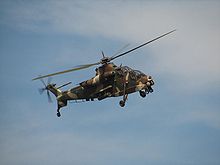 South African Denel AH-2 Rooivalk attack helicopter
South African Denel AH-2 Rooivalk attack helicopter
The South African National Defence Force (SANDF) was created in 1994,[44][45] as an all volunteer force composed of the former South African Defence Force, the forces of the African nationalist groups (Umkhonto we Sizwe and Azanian People's Liberation Army), and the former Bantustan defence forces.[44] The SANDF is subdivided into four branches, the South African Army, the South African Air Force, the South African Navy, and the South African Medical Service.[46] In recent years, the SANDF has become a major peacekeeping force in Africa,[47] and has been involved in operations in Lesotho, the Democratic Republic of the Congo,[47] and Burundi,[47] amongst others. It has also served in multi-national UN peacekeeping forces.
South Africa is the only African country to have successfully developed nuclear weapons. It became the first country (followed by Ukraine) with nuclear capability to voluntarily renounce and dismantle its programme and in the process signed the Nuclear Non-Proliferation Treaty in 1991.[48] South Africa undertook a nuclear weapons programme in the 1970s[48] According to former state president FW de Klerk, the decision to build a "nuclear deterrent" was taken "as early as 1974 against a backdrop of a Soviet expansionist threat."[49] South Africa may have conducted a nuclear test over the Atlantic in 1979,[50] though De Klerk asserted that South Africa had "never conducted a clandestine nuclear test."[49] Six nuclear devices were completed between 1980 and 1990, but all were destroyed before South Africa signed the Nuclear Non-Proliferation Treaty in 1991.[49]
International relations
Main article: Foreign relations of South AfricaAs the Union of South Africa, the country was a founding member of the United Nations. The then Prime Minister Jan Smuts wrote the preamble to the United Nations Charter.[51][52] The country is one of the founding members of the African Union (AU), and has the largest economy of all the members. It is also a founding member of the AU's New Partnership for Africa's Development (NEPAD). South Africa has played a key role as a mediator in African conflicts over the last decade, such as in Burundi, the Democratic Republic of Congo, the Comoros, and Zimbabwe. After apartheid ended, South Africa was readmitted to the Commonwealth of Nations. The country is a member of the Group of 77 and chaired the organisation in 2006. South Africa is also a member of the Southern African Development Community, South Atlantic Peace and Cooperation Zone, Southern African Customs Union, Antarctic Treaty System, World Trade Organization, International Monetary Fund, G20 and G8+5. South African President Jacob Zuma and Chinese President Hu Jintao upgraded bilateral ties between the two countries on 24 August 2010, when they signed the Beijing Agreement, which elevated South Africa's earlier "strategic partnership" with China to the higher level of "comprehensive strategic partnership" in both economic and political affairs, including the strengthening of exchanges between their respective ruling parties and legislatures.[53][54] In April 2011, South Africa formally joined the Brazil-Russia-India-China (BRICS) grouping of countries, identified by President Zuma as the country's largest trading partners, and also the largest trading partners with Africa as a whole. All five BRICS member countries are currently on the UN Security Council; Brazil, India and South Africa as non-permanent members. Zuma asserted that BRICS member countries would also work with each other through the UN, the Group of Twenty (G20) and the India, Brazil South Africa (IBSA) forum.[55]
Geography and environment
Main article: Geography of South AfricaSouth Africa is located at the southernmost region of Africa, with a long coastline that stretches more than 2,500 km (1,553 mi) and along two oceans (the South Atlantic and the Indian). At 1,219,912 km2 (471,011 sq mi),[56] South Africa is the 25th-largest country in the world and is comparable in size to Colombia. Mafadi in the Drakensberg at 3,450 m (11,320 ft) is the highest peak in South Africa. Excluding the Prince Edward Islands, the country lies between latitudes 22° and 35°S, and longitudes 16° and 33°E.
The interior of South Africa is a vast, flat, and sparsely populated scrubland, the Karoo, which is drier towards the northwest along the Namib desert. In contrast, the eastern coastline is lush and well-watered, which produces a climate similar to the tropics.
To the north of Johannesburg, the altitude drops beyond the escarpment of the Highveld, and turns into the lower lying Bushveld, an area of mixed dry forest and an abundance of wildlife. East of the Highveld, beyond the eastern escarpment, the Lowveld stretches towards the Indian Ocean. It has particularly high temperatures, and is also the location of extended subtropical agriculture.
South Africa also has one possession, the small sub-Antarctic archipelago of the Prince Edward Islands, consisting of Marion Island (290 km2/110 sq mi) and Prince Edward Island (45 km2/17 sq mi) (not to be confused with the Canadian province of the same name).
Climate
Main article: Climate of South AfricaSee also: ClimateSouth Africa has a generally temperate climate, due in part to being surrounded by the Atlantic and Indian Oceans on three sides, by its location in the climatically milder southern hemisphere and due to the average elevation rising steadily towards the north (towards the equator) and further inland. Due to this varied topography and oceanic influence, a great variety of climatic zones exist. Winters in South Africa occur between June and August.
The climatic zones vary, from the extreme desert of the southern Namib in the farthest northwest to the lush subtropical climate in the east along the Mozambique border and the Indian ocean. From the east, the land quickly rises over a mountainous escarpment towards the interior plateau known as the Highveld. Even though South Africa is classified as semi-arid, there is considerable variation in climate as well as topography.
The extreme southwest has a climate remarkably similar to that of the Mediterranean with wet winters and hot, dry summers, hosting the famous Fynbos Biome of grassland and thicket. This area also produces much of the wine in South Africa. This region is also particularly known for its wind, which blows intermittently almost all year. The severity of this wind made passing around the Cape of Good Hope particularly treacherous for sailors, causing many shipwrecks. Further east on the south coast, rainfall is distributed more evenly throughout the year, producing a green landscape. This area is popularly known as the Garden Route.
The Free State is particularly flat because it lies centrally on the high plateau. North of the Vaal River, the Highveld becomes better watered and does not experience subtropical extremes of heat. Johannesburg, in the centre of the Highveld, is at 1,740 m (5,709 ft) and receives an annual rainfall of 760 mm (29.9 in). Winters in this region are cold, although snow is rare.
The high Drakensberg mountains, which form the south-eastern escarpment of the Highveld, offer limited skiing opportunities in winter. The coldest place in South Africa is Sutherland in the western Roggeveld Mountains, where midwinter temperatures can reach as low as −15 °C (5 °F). The deep interior has the hottest temperatures: a temperature of 51.7 °C (125.06 °F) was recorded in 1948 in the Northern Cape Kalahari near Upington.[57]
Climate data for Cape Town, South Africa Month Jan Feb Mar Apr May Jun Jul Aug Sep Oct Nov Dec Year Average high °C (°F) 26.1
(79.0)26.5
(79.7)25.4
(77.7)23.0
(73.4)20.3
(68.5)18.1
(64.6)17.5
(63.5)17.8
(64.0)19.2
(66.6)21.3
(70.3)23.5
(74.3)24.9
(76.8)22.0 Average low °C (°F) 15.7
(60.3)15.6
(60.1)14.2
(57.6)11.9
(53.4)9.4
(48.9)7.8
(46.0)7.0
(44.6)7.5
(45.5)8.7
(47.7)10.6
(51.1)13.2
(55.8)14.9
(58.8)11.4 Precipitation mm (inches) 15
(0.59)17
(0.67)20
(0.79)41
(1.61)69
(2.72)93
(3.66)82
(3.23)77
(3.03)40
(1.57)30
(1.18)14
(0.55)17
(0.67)515
(20.28)Avg. precipitation days 5.5 4.6 4.8 8.3 11.4 13.3 11.8 13.7 10.4 8.7 4.9 6.2 103.6 Sunshine hours 337.9 299.9 291.4 234.0 204.6 174.0 192.2 210.8 225.0 279.0 309.0 334.8 3,092.2 Source: Hong Kong Observatory[58] Flora and fauna
See also: Wildlife of South Africa and Protected areas of South AfricaSouth Africa is ranked sixth out of the world’s seventeen megadiverse countries,[59] with more than 20,000 different plants, or about 10% of all the known species of plants on Earth, making it particularly rich in plant biodiversity. The most prevalent biome in South Africa is the grassland, particularly on the Highveld, where the plant cover is dominated by different grasses, low shrubs, and acacia trees, mainly camel-thorn and whitethorn. Vegetation becomes even more sparse towards the northwest due to low rainfall. There are several species of water-storing succulents like aloes and euphorbias in the very hot and dry Namaqualand area. The grass and thorn savannah turns slowly into a bush savannah towards the north-east of the country, with denser growth. There are significant numbers of baobab trees in this area, near the northern end of Kruger National Park.[60]
The Fynbos Biome, which makes up the majority of the area and plant life in the Cape floristic region, one of the six floral kingdoms, is located in a small region of the Western Cape and contains more than 9,000 of those species, making it among the richest regions on earth in terms of floral biodiversity. The majority of the plants are evergreen hard-leaf plants with fine, needle-like leaves, such as the sclerophyllous plants. Another uniquely South African plant is the protea genus of flowering plants. There are around 130 different species of protea in South Africa.
While South Africa has a great wealth of flowering plants, only 1% of South Africa is forest, almost exclusively in the humid coastal plain of KwaZulu-Natal, where there are also areas of Southern Africa mangroves in river mouths. There are even smaller reserves of forests that are out of the reach of fire, known as montane forests. Plantations of imported tree species are predominant, particularly the non-native eucalyptus and pine. South Africa has lost a large area of natural habitat in the last four decades, primarily due to overpopulation, sprawling development patterns and deforestation during the nineteenth century. South Africa is one of the worst affected countries in the world when it comes to invasion by alien species with many (e.g. Black Wattle, Port Jackson, Hakea, Lantana and Jacaranda) posing a significant threat to the native biodiversity and the already scarce water resources. The original temperate forest found by the first European settlers was exploited ruthlessly until only small patches remained. Currently, South African hardwood trees like Real Yellowwood (Podocarpus latifolius), stinkwood (Ocotea bullata), and South African Black Ironwood (Olea laurifolia) are under government protection.
Numerous mammals are found in the bushveld including lions, leopards, white rhinos, blue wildebeest, kudus, impalas, hyenas, hippopotamus and giraffes. A significant extent of the bushveld exists in the north-east including Kruger National Park and the Mala Mala Reserve, as well as in the far north in the Waterberg Biosphere.
Climate change is expected to bring considerable warming and drying to much of this already semi-arid region, with greater frequency and intensity of extreme weather events such as heatwaves, flooding and drought. According to computer generated climate modelling produced by the South African National Biodiversity Institute[61] parts of southern Africa will see an increase in temperature by about one degree Celsius along the coast to more than four degrees Celsius in the already hot hinterland such as the Northern Cape in late spring and summertime by 2050.
The Cape Floral Kingdom has been identified as one of the global biodiversity hotspots since it will be hit very hard by climate change and has such a great diversity of life. Drought, increased intensity and frequency of fire and climbing temperatures are expected to push many of these rare species towards extinction.
South Africa houses many endemic species, among them the critically endangered Riverine Rabbit (Bunolagus monticullaris) in the Karoo.
Flora and fauna of South Africa
The Protea, national flower of South AfricaThe Blue Crane is the national bird of South AfricaEconomy
Main article: Economy of South Africa Table Mountain. Cape Town has become an important retail and tourism centre for the country, and attracts the largest number of foreign visitors in South Africa
Table Mountain. Cape Town has become an important retail and tourism centre for the country, and attracts the largest number of foreign visitors in South Africa
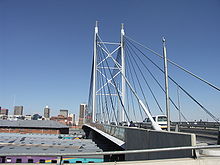 The Nelson Mandela Bridge in Johannesburg. Gauteng produces 33% of South Africa's GDP and 10% of the African continent's GDP
The Nelson Mandela Bridge in Johannesburg. Gauteng produces 33% of South Africa's GDP and 10% of the African continent's GDP
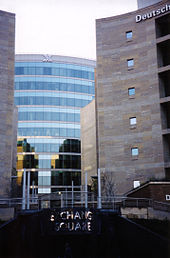 JSE is the largest stock exchange on the African continent
JSE is the largest stock exchange on the African continent
South Africa has a mixed economy with high rate of poverty and low GDP per capita. Unemployment is extremely high and South Africa is ranked in the top 10 countries in the world for income inequality,[62][63][64] measured by the Gini coefficient. During 1995–2003, the number of formal jobs decreased and informal jobs increased; overall unemployment worsened.[35] In 2000 the average white household was earning six times more than the average black household.[65]
The government's Black Economic Empowerment policies have drawn criticism from the Development Bank of Southern Africa's lead economist[who?] for focusing "almost exclusively on promoting individual ownership by black people (which) does little to address broader economic disparities, though the rich may become more diverse."[66] Official affirmative action policies have seen a rise in black economic wealth and an emerging black middle class.[67] Other problems include state ownership and interference, which impose high barriers to entry in many areas.[68] Restrictive labour regulations have contributed to the unemployment malaise.[35]
After 1994 government policy brought down inflation, stabilised public finances, and some foreign capital was attracted, however growth was still subpar.[69] From 2004 onward economic growth picked up significantly; both employment and capital formation increased.[69]
South Africa is a popular tourist destination, and a substantial amount of revenue comes from tourism.[70] Illegal immigrants are involved in informal trading.[71] Many immigrants to South Africa continue to live in poor conditions, and the immigration policy has become increasingly restrictive since 1994.[72]
Principal international trading partners of South Africa—besides other African countries—include Germany, the United States, China, Japan, the United Kingdom and Spain.[73]
Income and human development
South Africa is a developing country with a wide income gap between its wealthiest citizens and its poorest. World Bank research shows that South Africa has one of the widest gaps between per capita GNP versus its Human Development Index ranking, with only Botswana showing a larger gap.[74] One study using calculations based on National Income Dynamics Study (NIDS) data suggests that 47% of South Africans live below the poverty line: 56% of blacks live in poverty compared to 2% of whites, using an arbitrary income poverty line of R502 per capita.[75] The United Nations Development Program's Human Development Index (HDI) ranked South Africa 110 out of 169 countries in 2010. The report notes, however, that the region's assessment has improved slowly since 1980. The HDI includes a Human Poverty Index (HPI-1), which ranked South Africa 85 out of 135 countries.
The HPI-1 includes the following human poverty indicators:[76]
Indicator Percentage International ranking (2010) Probability of not surviving to age 40 36 143 Adult illiteracy rate (15 years and older) 12 80 People not using an improved water source 7 56 Children underweight for age (aged 5 years and younger) 12 68 Income inequality in South Africa is strongly influenced by the country's Apartheid legacy and large differences can be identified along racial lines, unlike other countries in the region.[citation needed] The number of South Africans living below the poverty line, identified according to Apartheid-era social categories, was calculated in one study as 56% "black", 27% "coloured", 9% "India", and 2% "white".[75] In the past inequality in South Africa was largely defined along race lines, but it has become increasingly defined by inequality within population groups as the gap between rich and poor within each group has increased substantially.[77]
The Organization for Economic Cooperation and Development proposals for addressing income inequality included: encouraging more saving and investment; a liberalisation of product-market regulation; easier access to credit for small businesses; greater co-ordination in wage bargaining; and measures to tackle the high level of youth unemployment. Some proposals have included wage subsidies for people being trained, a minimum wage differentiated by age, and extended periods of probation for young workers.[78]
A 2011 study published by the University of Cape Town about the richest 10% found that nearly 40% are black, where this group had once been almost exclusively white.[79] While only 29% of the absolute wealthiest[vague] South Africans are black, this jumps to 50% among the “entry-level” rich (defined as earning more than $4,000).[79] Factors that were found to be common among those in the entry-level rich group include being young, entrepreneurial and having some post-secondary education.[79]
Unlike most of the world’s poor countries, South Africa does not have a thriving informal economy; according to OECD estimates, only 15% of South African jobs are in the shadow economy, compared with around half in Brazil and India and nearly three-quarters in Indonesia. The OECD attributes this difference to South Africa's widespread welfare system.[78]
Science and technology
Main article: Science and technology in South AfricaSeveral important scientific and technological developments have originated in South Africa. The first human-to-human heart transplant was performed by cardiac surgeon Christiaan Barnard at Groote Schuur Hospital in December 1967. Max Theiler developed a vaccine against Yellow Fever, Allan McLeod Cormack pioneered x-ray Computed tomography, and Aaron Klug developed crystallographic electron microscopy techniques. These advancements were all (with the exception of that of Barnard) recognised with Nobel Prizes. Sydney Brenner won most recently, in 2002, for his pioneering work in molecular biology.
Mark Shuttleworth founded an early Internet security company Thawte, that was subsequently bought out by world-leader VeriSign. Despite government efforts to encourage entrepreneurship in biotechnology, IT and other high technology fields, no other notable groundbreaking companies have been founded in South Africa. It is the expressed objective of the government to transition the economy to be more reliant on high technology, based on the realisation that South Africa cannot compete with Far Eastern economies in manufacturing, nor can the republic rely on its mineral wealth in perpetuity.
South Africa has cultivated a burgeoning astronomy community. It hosts the Southern African Large Telescope, the largest optical telescope in the southern hemisphere. South Africa is currently building the Karoo Array Telescope as a pathfinder for the €1.5 billion Square Kilometer Array project.[80] South Africa is a finalist, with Australia, to be the host of the SKA.
Agriculture
Main article: Agriculture in South AfricaAgriculture in South Africa
Grain elevators are a common sight in the Free State and other regions of South AfricaThe South African agricultural industry contributes around 10% of formal employment, relatively low compared to other parts of Africa, as well as providing work for casual labourers and contributing around 2.6% of GDP for the nation.[81] Due to the aridity of the land, only 13.5% can be used for crop production, and only 3% is considered high potential land.[82]
According to FAOSTAT, South Africa is one of world's largest producers of: chicory roots (4th); grapefruit (4th); cereals (5th); green maize and maize (7th); castor oil seed (9th); pears (9th); sisal (10th); fibre crops (10th).[83]
The dairy industry consists of around 4,300 milk producers providing employment for 60,000 farm workers and contributing to the livelihoods of around 40,000 others.[84]
The South African government has set a target of transferring 30% of productive farmland from whites to 'previously disadvantaged' blacks by 2014.[85] Land reform has been criticised both by farmers' groups and by landless workers, the latter alleging that the pace of change has not been fast enough, and the former alleging 'racist' treatment and expressing concerns that a similar situation to Zimbabwe's land reform policy may develop,[86] a fear exacerbated by comments made by former deputy president Phumzile Mlambo-Ngcuka.[87][88]
The government has been accused of either putting in too much effort,[89][dated info] or not enough effort,[90] to tackle the problem of farm attacks as opposed to other forms of violent crime.
Some predictions show surface water supply could decrease by 60% by the year 2070 in parts of the Western Cape.[91] To reverse the damage caused by land mismanagement, the government has supported a scheme which promotes sustainable development and the use of natural resources.[92] Maize production, which contributes to a 36% majority of the gross value of South Africa’s field crops, has also experienced negative effects due to climate change. The estimated value of loss, which takes into consideration scenarios with and without the carbon dioxide fertilisation effect,[93] ranges between tens and hundreds of millions of Rands.[94]
Electricity crisis
After unsuccessful attempts by the government to encourage private construction of power generation capacity, the state-owned power supplier Eskom started experiencing deficiency in capacity in the electrical generating and reticulation infrastructure in 2007. This lack led to an inability to meet the routine demands of industry and consumers, resulting in countrywide rolling blackouts. Initially, the lack of capacity was triggered by a failure at Koeberg nuclear power station, but a general lack of capacity due to increased demand then become evident. The supplier has been widely criticised for failing to adequately plan for and construct sufficient electrical generating capacity,[95] although ultimately the government admitted that it was at fault for refusing to approve funding for investment in infrastructure.[96]
The crisis was resolved within a few months, but the margin between national demand and available capacity is still low (particularly in peak hours), and power stations are under strain, such that another phase of rolling blackouts is probable if parts of the supply are halted for whatever reason. The government and Eskom are currently planning new power stations. The power utility plans to have 20,000 megawatts of nuclear power in its grid by 2025.[97][98]
Demographics
Main article: Demographics of South AfricaHistorical populations Year Pop. ±% 1900 5,014,000 — 1910 5,842,000 +16.5% 1920 6,953,000 +19.0% 1930 8,580,000 +23.4% 1940 10,341,000 +20.5% 1950 13,310,000 +28.7% 1960 16,385,000 +23.1% 1970 21,794,000 +33.0% 1980 24,261,000 +11.3% 1990 37,944,000 +56.4% 2000 43,686,000 +15.1% 2010 (est.)[99] 49,109,107 +12.4% Demographics of South Africa
The many migrations that formed the modern Rainbow NationSouth Africa is a nation of about 50 million people of diverse origins, cultures, languages, and religions. The last census was held in 2001 and the next will be in 2011. Even though the population of South Africa has increased in the past decade[100][101] (primarily due to immigration), the country had an annual population growth rate of −0.051% in 2010 (CIA est.), where the birth rate is higher than the death rate but there is a net emigration rate.[99][102] South Africa is home to an estimated 5 million illegal immigrants, including some 3 million Zimbabweans.[103][104][105] A series of anti-immigrant riots occurred in South Africa beginning on 11 May 2008.[106][107]
Statistics South Africa provided five racial categories by which people could classify themselves, the last of which, "unspecified/other" drew negligible responses, and these results were omitted.[100] The 2010 midyear estimated figures for the other categories were Black African at 79.4%, White at 9.2%, Coloured at 8.8%, and Indian or Asian at 2.6%.[108] The first census in South Africa in 1911 showed that whites made up 22% of the population; it declined to 16% in 1980.[109]
By far the major part of the population classified itself as African or black, but it is not culturally or linguistically homogeneous. Major ethnic groups include the Zulu, Xhosa, Basotho (South Sotho), Bapedi (North Sotho), Venda, Tswana, Tsonga, Swazi and Ndebele, all of which speak Bantu languages.
The colored population is mainly concentrated in the Cape region, and come from a combination of of ethnic backgrounds including White, Khoi, San, Griqua, Chinese and Malay.[110]
White South Africans are descendants of Dutch, German, French Huguenots, English and other European and Jewish settlers.[110][111] Culturally and linguistically, they are divided into the Afrikaners, who speak Afrikaans, and English-speaking groups. The white population has been on the decrease due to a low birth rate and emigration; as a factor in their decision to emigrate, many cite the high crime rate and the affirmative action policies of the government.[112][113] Since 1994, approximately 440,000 white South Africans have permanently emigrated.[108] Despite high emigration levels, a few immigrants from Europe have settled in the country. By 2005, an estimated 212,000 British citizens were residing in South Africa. By 2011, this number may have grown to 500,000.[114] Some white Zimbabwean emigrated to South Africa. Some of the more nostalgic members of the community are known in popular culture as "Whenwes", because of their nostalgia for their lives in Rhodesia "when we were in Rhodesia".[115]
The Indian population came to South Africa as indentured labourers to work in the sugar plantations in Natal in the late 19th and early 20th century.[110] They came from different parts of the Indian subcontinent, adhered to different religions and spoke different languages.[110] Serious riots in Durban between Indians and Zulus erupted in 1949.[116] There is also a significant group of Chinese South Africans (approximately 100,000 individuals) and Vietnamese South Africans (approximately 50,000 individuals). In 2008, the Pretoria High Court has ruled that Chinese South Africans who arrived before 1994 are to be reclassified as Coloureds. As a result of this ruling, about 12,000–15,000[117] ethnically Chinese citizens who arrived before 1994, numbering 3%–5% of the total Chinese population in the country, will be able to benefit from government BEE policies.[118]
South Africa hosts a sizeable refugee and asylum seeker population. According to the World Refugee Survey 2008, published by the U.S. Committee for Refugees and Immigrants, this population numbered approximately 144,700 in 2007.[119] Groups of refugees and asylum seekers numbering over 10,000 included people from Zimbabwe (48,400), The Democratic Republic of the Congo (24,800), and Somalia (12,900).[119] These populations mainly lived in Johannesburg, Pretoria, Durban, Cape Town, and Port Elizabeth.[119] Many refugees have now also started to work and live in rural areas in provinces such as Mpumalanga and KwaZulu-Natal.
Religion
Main article: Religion in South AfricaAccording to the 2001 national census, Christians accounted for 79.7% of the population. This includes Zion Christian (11.1%), Pentecostal (Charismatic) (8.2%), Roman Catholic (7.1%), Methodist (6.8%), Dutch Reformed (6.7%), Anglican (3.8%); members of other Christian churches accounted for another 36% of the population. Muslims accounted for 1.5% of the population, Hindus about 1.3%, and Judaism 0.2%. 15.1% had no religious affiliation, 2.3% were other and 1.4% were unspecified.[73][120][121]
African Indigenous Churches were the largest of the Christian groups. It was believed that many of these persons who claimed no affiliation with any organised religion adhered to traditional indigenous religions. Many peoples have syncretic religious practices combining Christian and indigenous influences.[122]
Islam in South Africa constitute mostly of those are described as Coloureds and those who are described as Indians. They have been joined by black or white South African converts as well as others from other parts of Africa.[123] South African Muslims claim that their faith is the fastest-growing religion of conversion in the country, with the number of black Muslims growing sixfold, from 12,000 in 1991 to 74,700 in 2004[123][124]
The Hindu population was primarily established during British colonial period, but later waves of immigration from India have also contributed to it. Most Hindus are ethnically South Asian but there are many who come from mixed racial stock, and some are converts with the efforts of Hindu missionaries such as ISKCON.
Other minority religions in South Africa are Sikhism, Jainism, and Bahá'í Faith.[120]
Languages
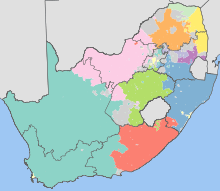 Map showing dominant South African languages.
Map showing dominant South African languages. AfrikaansEnglishNdebeleXhosaZuluNorthern SothoSothoTswanaSwaziVendaTsongaNone dominantMain article: Languages of South Africa
AfrikaansEnglishNdebeleXhosaZuluNorthern SothoSothoTswanaSwaziVendaTsongaNone dominantMain article: Languages of South AfricaSouth Africa has eleven official languages:[125] Afrikaans, English, Ndebele, Northern Sotho, Sotho, Swazi, Tswana, Tsonga, Venda, Xhosa, and Zulu. In this regard it is third only to Bolivia and India in number. While all the languages are formally equal, some languages are spoken more than others. According to the 2001 National Census, the three most spoken first home languages are Zulu (23.8%), Xhosa (17.6%), and Afrikaans (13.3%).[100] Despite the fact that English is recognised as the language of commerce and science, it was spoken by only 8.2% of South Africans at home in 2001, an even lower percentage than in 1996 (8.6%).[100]
The country also recognises several unofficial languages, including Fanagalo, Khoe, Lobedu, Nama, Northern Ndebele, Phuthi, San, and South African Sign Language.[126] These unofficial languages may be used in certain official uses in limited areas where it has been determined that these languages are prevalent. Nevertheless, their populations are not such that they require nationwide recognition.
Many of the "unofficial languages" of the San and Khoikhoi people contain regional dialects stretching northwards into Namibia and Botswana, and elsewhere. These people, who are a physically distinct population from other Africans, have their own cultural identity based on their hunter-gatherer societies. They have been marginalised to a great extent, and many of their languages are in danger of becoming extinct.
Many white South Africans also speak other European languages, such as Portuguese (also spoken by black Angolans and Mozambicans), German, and Greek, while some Asians and Indians in South Africa speak South Asian languages, such as Tamil, Hindi, Gujarati, Urdu, and Telugu. French is still widely spoken by French South Africans[citation needed] especially in places like Franschhoek, where many South Africans are of French origin. South African French is spoken by fewer than 10,000 individuals. Congolese French is also spoken in South Africa by migrants.
Largest municipalities
In 2007, there were 6 municipalities with more than 1 million inhabitants,[127] and 8 with between 500,000 and 1 million inhabitants (in 2001 there were 6). Municipalities in the list may include several towns. Some of them consist of hundreds of tiny settlements in very close proximity to each other. This is particularly true of municipalities made up of former Bantustans, e.g. KaNgwane and QwaQwa, and Libode in Transkei, where distributed, non-Western settlement models are practised.
Health
Main articles: Healthcare in South Africa and HIV/AIDS in South AfricaThe spread of AIDS (acquired immuno-deficiency syndrome) is an alarming problem in South Africa with up to 31% of pregnant women found to be HIV infected in 2005 and the infection rate among adults estimated at 20%.[129] The link between HIV, a virus spread primarily by sexual contact, and AIDS was long denied by prior president Thabo Mbeki and then health minister Manto Tshabalala-Msimang, who insisted that the many deaths in the country are due to malnutrition, and hence poverty, and not HIV.[130] According to the South African Institute of Race Relations, the life expectancy in 2009 was 71 years for a white South African and 48 years for a black South African.[131]
In 2007, in response to international pressure, the government made efforts to fight AIDS.[132] In September 2008 Thabo Mbeki was recalled by the ANC and chose to resign and Kgalema Motlanthe was appointed for the interim. One of Motlanthe's first actions was to replace Tshabalala-Msimang with Barbara Hogan who immediately started working to improve the Government's approach to AIDS. After the 2009 General Elections, President Jacob Zuma appointed Dr Aaron Motsoaledi as the new minister and committed his government to increasing funding for and widening the scope of AIDS treatment.[133]
AIDS affects mainly those who are sexually active and is far more prevalent in the black population. Most deaths are people who are also economically active, resulting in many families losing their primary wage earners. This has resulted in many 'AIDS orphans' who in many cases depend on the state for care and financial support.[134] It is estimated that there are 1,200,000 orphans in South Africa.[134] Many elderly people also lose the support from lost younger members of their family. Roughly 5 million people are infected with the disease.[132]
Society and culture
Main article: Culture of South AfricaSouth African culture is diverse; foods from many cultures are enjoyed by all and especially marketed to tourists who wish to sample the large variety of South African cuisine. In addition to food, music and dance feature prominently.[citation needed]
South African cuisine is heavily meat-based and has spawned the distinctively South African social gathering known as a braai, or barbecue. South Africa has also developed into a major wine producer, with some of the best vineyards lying in valleys around Stellenbosch, Franschoek, Paarl and Barrydale.[135]
The South African black majority still has a substantial number of rural inhabitants who lead largely impoverished lives. It is among these people that cultural traditions survive most strongly; as blacks have become increasingly urbanised and Westernised, aspects of traditional culture have declined. Urban blacks usually speak English or Afrikaans in addition to their native tongue. There are smaller but still significant groups of speakers of Khoisan languages who are not included in the eleven official languages, but are one of the eight other officially recognised languages. There are small groups of speakers of endangered languages, most of which are from the Khoi-San family, that receive no official status; some groups within South Africa are attempting to promote their use and revival.
Members of the middle class, who are predominantly white but whose ranks include growing numbers of black, coloured and Indian people,[136] have lifestyles similar in many respects to that of people found in Western Europe, North America and Australasia. Members of the middle class often study and work abroad for greater exposure to the markets of the world.
Asians, predominantly of Indian origin, preserve their own cultural heritage, languages and religious beliefs, being either Christian, Hindu or Sunni Muslim and speaking English, with Indian languages like Hindi, Telugu, Tamil or Gujarati being spoken less frequently, but the majority of Indians being able to understand their mother tongue. The first Indians arrived on the famous Truro ship as indentured labourers in Natal to work the Sugar Cane Fields. There is a much smaller Chinese community in South Africa, although its numbers have increased due to immigration from Republic of China (Taiwan).
South Africa has also had a large influence in the Scouting movement, with many Scouting traditions and ceremonies coming from the experiences of Robert Baden-Powell (the founder of Scouting) during his time in South Africa as a military officer in the 1890s. The South African Scout Association was one of the first youth organisations to open its doors to youth and adults of all races in South Africa. This happened on 2 July 1977 at a conference known as Quo Vadis.[137]
In 2006, South Africa became the fifth country in the world, and the first in Africa, to legalise same-sex marriage.
Art
Main article: South African artThe oldest art objects in the world were discovered in a South African cave. Dating from 75,000 years ago,[138] these small drilled snail shells could have no other function than to have been strung on a string as a necklace. South Africa was one of the cradles of the human species. One of the defining characteristics of our species is the making of art (from Latin 'ars' meaning worked or formed from basic material).
The scattered tribes of Khoisan peoples moving into South Africa from around 10000 BC had their own fluent art styles seen today in a multitude of cave paintings. They were superseded by Bantu/Nguni peoples with their own vocabularies of art forms. In the 20th century, traditional tribal forms of art were scattered and re-melded by the divisive policies of apartheid.
New forms of art evolved in the mines and townships: a dynamic art using everything from plastic strips to bicycle spokes. The Dutch-influenced folk art of the Afrikaner Trekboers and the urban white artists earnestly following changing European traditions from the 1850s onwards also contributed to this eclectic mix, which continues to evolve today.
Literature
Main article: South African literatureSouth Africa's unique social and political history have generated a strong group of local writers, with themes that span the days of apartheid to the lives of people in the "new South Africa".
Many of the first black South African authors were missionary-educated, and the majority of which thus wrote in either English or Afrikaans. One of the first well known novels written by a black author in an African language was Solomon Thekiso Plaatje's Mhudi, written in 1930.
Notable white South African authors include Nadine Gordimer who was, in Seamus Heaney's words, one of "the guerrillas of the imagination", and who became the first South African and the seventh woman to be awarded the Nobel Prize for Literature in 1991. Her most famous novel, July's People, was released in 1981, depicting the collapse of white-minority rule.
J.M. Coetzee was the second South African to win the Nobel Prize for Literature, in 2003. When awarding the prize, the Swedish Academy stated that Coetzee "in innumerable guises portrays the surprising involvement of the outsider".[139] The press release for the award also cited his "well-crafted composition, pregnant dialogue and analytical brilliance," while focusing on the moral nature of his work.[139]
Athol Fugard, whose plays have been regularly premiered in fringe theatres in South Africa, London (The Royal Court Theatre) and New York. Olive Schreiner's The Story of an African Farm (1883) was a revelation in Victorian literature: it is heralded by many as introducing feminism into the novel form.
Alan Paton published the acclaimed novel Cry, the Beloved Country in 1948. He told the tale of a black priest who comes to Johannesburg to find his son, which became an international best-seller. During the 1950s, Drum magazine became a hotbed of political satire, fiction, and essays, giving a voice to urban black culture.
Afrikaans-language writers also began to write controversial material. Breyten Breytenbach was jailed for his involvement with the guerrilla movement against apartheid. Andre Brink was the first Afrikaner writer to be banned by the government after he released the novel A Dry White Season about a white South African who discovers the truth about a black friend who dies in police custody.
J. R. R. Tolkien, author of The Hobbit, The Lord of the Rings and The Silmarillion, was born in Bloemfontein in 1892.
Cinema
Main article: Cinema of South AfricaWhile many foreign films have been produced about South Africa (usually involving race relations), few local productions are known outside South Africa itself. One exception was the film The Gods Must Be Crazy in 1980, set in the Kalahari. This is about how life in a traditional community of Bushmen is changed when a Coke bottle, thrown out of an aeroplane, suddenly lands from the sky. The late Jamie Uys, who wrote and directed The Gods Must Be Crazy, also had success overseas in the 1970s with his films Funny People and Funny People II, similar to the TV series Candid Camera in the US. Leon Schuster's You Must Be Joking! films are in the same genre, and hugely popular among South Africans.
Arguably, the most high-profile film portraying South Africa in recent years was District 9. Directed by Neill Blomkamp, a native South African, and produced by Peter Jackson, the action/science-fiction film depicts a sub-class of alien refugees forced to live in the slums of Johannesburg in what many saw as a creative allegory for apartheid. The film was a critical and commercial success worldwide, and was nominated for Best Picture at the 82nd Academy Awards.
Other notable exceptions are the film Tsotsi, which won the Academy Award for Foreign Language Film at the 78th Academy Awards in 2006 as well as U-Carmen e-Khayelitsha, which won the Golden Bear at the 2005 Berlin International Film Festival.
Music
Main article: Music of South AfricaThere is great diversity in music from South Africa. Many black musicians who sang in Afrikaans or English during apartheid have since begun to sing in traditional African languages, and have developed a unique style called Kwaito. Of note is Brenda Fassie, who launched to fame with her song "Weekend Special", which was sung in English. More famous traditional musicians include Ladysmith Black Mambazo, while the Soweto String Quartet performs classic music with an African flavour. White and Coloured South African singers are historically influenced by European musical styles. South Africa has produced world-famous jazz musicians, notably Hugh Masekela, Jonas Gwangwa, Abdullah Ibrahim, Miriam Makeba, Jonathan Butler, Chris McGregor, and Sathima Bea Benjamin. Afrikaans music covers multiple genres, such as the contemporary Steve Hofmeyr and the punk rock band Fokofpolisiekar. Crossover artists such as Verity (internationally recognised for innovation in the music industry) and Johnny Clegg and his bands Juluka and Savuka have enjoyed various success underground, publicly, and abroad.
The South African music scene includes Kwaito, a new music genre that had developed in the mid 80s and has since developed to become the most popular social economical form of representation among the populous. Though some may argue that the political aspects of Kwaito has since diminished after Apartheid, and the relative interest in politics has become a minor aspect of daily life. Some argue that in a sense, Kwaito is in fact a political force that shows activism in its apolitical actions. Today, major corporations like Sony, BMG, and EMI have appeared on the South African scene to produce and distribute Kwaito music. Due to its overwhelming popularity, as well as the general influence of DJs, who are among the top 5 most influential types of people within the country[citation needed], Kwaito has taken over radio, television, and magazines.[140]
Sports
Main article: Sport in South AfricaSport in South Africa
The Springboks in a bus parade after winning the 2007 Rugby World CupSouth Africa's most popular sports are soccer, rugby and cricket.[141] Other sports with significant support are swimming, athletics, golf, boxing, tennis and netball. Although soccer commands the greatest following among the youth, other sports like basketball, surfing and skateboarding are increasingly popular.
Soccer players who have played for major foreign clubs include Steven Pienaar (Tottenham), Lucas Radebe and Philemon Masinga (both formerly of Leeds United), Quinton Fortune (Atletico Madrid and Manchester United), Benni McCarthy (Ajax Amsterdam, F.C. Porto, Blackburn Rovers and West Ham United), Aaron Mokoena (Ajax Amsterdam, Blackburn Rovers and Portsmouth), and Delron Buckley (Borussia Dortmund). Famous boxing personalities include Baby Jake Jacob Matlala, Vuyani Bungu, Welcome Ncita, Dingaan Thobela, Gerrie Coetzee and Brian Mitchell. Durban Surfer Jordy Smith won the 2010 Billabong J-Bay competition making him the no 1 ranked surfer in the world. South Africa produced Formula One motor racing's 1979 world champion Jody Scheckter. Famous current cricket players include Herschelle Gibbs, Graeme Smith, Jacques Kallis, JP Duminy, etc. Most of them also participate in the Indian Premier League.
South Africa has also produced numerous world class rugby players, including Francois Pienaar, Joost van der Westhuizen, Danie Craven, Frik du Preez, Naas Botha and Bryan Habana. South Africa hosted and won the 1995 Rugby World Cup and won the 2007 Rugby World Cup in France. It followed the 1995 Rugby World Cup by hosting the 1996 African Cup of Nations, with the national team going on to win the tournament. It also hosted the 2003 Cricket World Cup, the 2007 World Twenty20 Championship, and it was the host nation for the 2010 FIFA World Cup, which was the first time the tournament was held in Africa. FIFA president Sepp Blatter awarded South Africa a grade 9 out of 10 for successfully hosting the event.[142]
In 2004, the swimming team of Roland Schoeman, Lyndon Ferns, Darian Townsend and Ryk Neethling won the gold medal at the Olympic Games in Athens, simultaneously breaking the world record in the 4x100 freestyle relay. Penny Heyns won Olympic Gold in the 1996 Atlanta Olympic Games.
In golf, Gary Player is generally regarded as one of the greatest golfers of all time, having won the Career Grand Slam, one of five golfers to have done so. Other South African golfers to have won major tournaments include Bobby Locke, Ernie Els, Retief Goosen, Trevor Immelman and Louis Oosthuizen .
Education
Main article: Education in South AfricaFurther information: Matriculation in South Africa, High school#South Africa, List of universities in South Africa, List of business schools in South Africa, List of post secondary institutions in South Africa, Category:Higher education in South Africa, Rankings of universities in South Africa, and Rankings of business schools in South Africa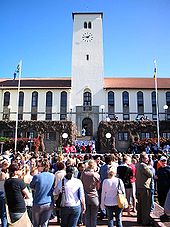 The heart of the Rhodes University campus
The heart of the Rhodes University campus
South Africa has a 3 tier system of education starting with primary school, followed by high school and tertiary education in the form of (academic) universities and universities of technology. Learners have twelve years of formal schooling, from grade 1 to 12. Grade R is a pre-primary foundation year. [143] Primary schools span the first seven years of schooling.[144] High School education spans a further five years. The Senior Certificate examination takes place at the end of grade 12 and is necessary for tertiary studies at a South African university.[143]
Public universities in South Africa are divided into three types: traditional universities, which offer theoretically oriented university degrees; universities of technology ("Technikons"), which offer vocational oriented diplomas and degrees; and comprehensive universities, which offer both types of qualification. There are 23 public universities in South Africa: 11 traditional universities, 6 universities of technology and 6 comprehensive universities. Public institutions are usually English medium, although instruction may take place in Afrikaans as well. There are also a large number of other educational institutions in South Africa – some are local campuses of foreign universities, some conduct classes for students who write their exams at the distance-education University of South Africa and some offer unaccredited or non-accredited diplomas. Both public and private universities and colleges register with the Department of Higher Education and Training and are accredited by the Council on Higher Education (CHE). Rankings of universities and business schools in South Africa are largely based on international university rankings, because there have not as yet been published any specifically South African rankings.
Under apartheid, schools for blacks were subject to discrimination through inadequate funding and a separate syllabus called Bantu Education which was only designed to give them sufficient skills to work as labourers.[145] In 2004 South Africa started reforming its higher education system, merging and incorporating small universities into larger institutions, and renaming all higher education institutions "university" in order to redressing these imbalances.
Public expenditure on education was at 5.4 % of the 2002–05 GDP.[146]
Social problems
Crime
Main article: Crime in South AfricaAccording to a survey for the period 1998–2000 compiled by the United Nations, South Africa was ranked second for murder and first for assaults and rapes per capita.[147] Nearly 50 murders are committed each day in South Africa.[148] Total crime per capita is 10th out of the 60 countries in the data set.[citation needed] Middle-class South Africans seek security in gated communities.[citation needed] Many emigrants from South Africa also state that crime was a big motivator for them to leave.[149] Crime against the farming community has continued to be a major problem.[150]
Sexual violence
Main article: Sexual violence in South AfricaIt is estimated that 500,000 women are raped in South Africa every year[151] with the average woman more likely to be raped than complete secondary school.[152] A 2009 survey found one in four South African men admitted to raping someone[153] and another survey found one in three women out of 4000 surveyed women said they had been raped in the past year.[154] Rapes are also perpetrated by children (some as young as ten).[155] Child and baby rape incidences are some of the highest in the world and a number of high profile cases have outraged the nation.[156]
Brain drain
Along with many African nations, South Africa has been experiencing a "brain drain" in the past 20 years. This is believed to be potentially damaging for the regional economy,[157][not in citation given][clarification needed] and is almost certainly detrimental for the well-being of the majority of people reliant on the healthcare infrastructure, given the HIV/AIDS epidemic.[158][clarification needed] The skills drain in South Africa tends to demonstrate racial contours (naturally given the skills distribution legacy of South Africa) and has thus resulted in large white South African communities abroad.[159] However, the statistics which purport to show a brain drain are disputed and also do not account for repatriation and expiry of foreign work contracts. According to several surveys[160][161] there has been a reverse in brain drain following the global financial crisis of 2008-2009 and expiration of foreign work contracts. In the first quarter of 2011, confidence levels for graduate professionals were recorded at a level of 84% in a PPS survey.[162]
Xenophobia
Main article: Xenophobia in South AfricaIn May 2008, riots left over sixty people dead.[164] The Centre on Housing Rights and Evictions estimates over 100,000 people were driven from their homes.[165] Migrants and refugees seeking asylum were the targets, but a third of the victims were South African citizens.[164] In a 2006 survey, the South African Migration Project concluded that South Africans are more opposed to immigration than anywhere else in the world.[166] The United Nations High Commissioner for Refugees in 2008 over 200,000 refugees applied for asylum in South Africa, almost four times as many as the year before.[167] These people were mainly from Zimbabwe, though many also come from Burundi, Democratic Republic of the Congo, Rwanda, Eritrea, Ethiopia and Somalia.[167] Competition over jobs, business opportunities, public services and housing has led to tension between refugees and host communities.[167] While xenophobia is still a problem, recent violence has not been as widespread as initially feared.[167]
See also
References
- ^ "The Constitution". Constitutional Court of South Africa. http://www.constitutionalcourt.org.za/site/theconstitution/thetext.htm. Retrieved 3 September 2009.
- ^ "Principal Agglomerations of the World". Citypopulation.de. http://www.citypopulation.de/World.html. Retrieved 30 October 2011.
- ^ The Khoi, Nama and San languages; sign language; German, Greek, Gujarati, Hindi, Portuguese, Tamil, Telegu and Urdu; and Arabic, Hebrew, Sanskrit and "other languages used for religious purposes in South Africa" have a special status. See Chapter 1, Article 6, of the Constitution.
- ^ a b c "Mid-year population estimates 2011". Statistics South Africa. 2011. http://www.statssa.gov.za/publications/P0302/P03022011.pdf. Retrieved 30 July 2011.
- ^ "Census 2001 at a glance". Statistics South Africa. http://www.statssa.gov.za/census01/html/default.asp. Retrieved 7 July 2008.
- ^ a b c d "South Africa". International Monetary Fund. http://www.imf.org/external/pubs/ft/weo/2011/02/weodata/weorept.aspx?pr.x=65&pr.y=1&sy=2009&ey=2016&scsm=1&ssd=1&sort=country&ds=.&br=1&c=199&s=NGDPD%2CNGDPDPC%2CPPPGDP%2CLP&grp=0&a=. Retrieved 2011-September-20.
- ^ "Gini Index". World Bank. http://data.worldbank.org/indicator/SI.POV.GINI/. Retrieved 2 March 2011.
- ^ "South African Maritime Safety Authority". South African Maritime Safety Authority. http://www.samsa.org.za/. Retrieved 16 June 2008.
- ^ "Coastline". The World Factbook. CIA. https://www.cia.gov/library/publications/the-world-factbook/fields/2060.html. Retrieved 16 June 2008.
- ^ a b c d "South Africa Fast Facts". SouthAfrica.info. April 2007. http://www.southafrica.info/about/facts.htm. Retrieved 14 June 2008.
- ^ Guy Arnold. "Lesotho: Year In Review 1996 – Britannica Online Encyclopedia". Britannica.com. http://www.britannica.com/eb/article-9113829/LESOTHO. Retrieved 30 October 2011.
- ^ "South Africa – World Bank". Data.worldbank.org. http://data.worldbank.org/country/south-africa. Retrieved 30 October 2011.
- ^ Data refers to the year 2010. World Development Indicators database, World Bank. Accessed on 30 September 2011.
- ^ "South Africa’s Unemployment Rate Increases to 23.5%". Bloomberg. 5 May 2009. http://www.bloomberg.com/apps/news?pid=20601116&sid=aoB7RbcZCRfU. Retrieved 30 May 2010.
- ^ "HDI". UNDP. http://hdr.undp.org/en/media/HDI_2008_EN_Tables.pdf.
- ^ Wymer, John; Singer, R (1982). The Middle Stone Age at Klasies River Mouth in South Africa. Chicago: University of Chicago Press. ISBN 0226761037.
- ^ Deacon, HJ (2001). "Guide to Klasies River". Stellenbosch University. p. 11. http://academic.sun.ac.za/archaeology/KRguide2001.PDF. Retrieved 5 September 2009.
- ^ "Fossil Hominid Sites of Sterkfontein, Swartkrans, Kromdraai, and Environs". http://whc.unesco.org/en/list/915.
- ^ Stephen P. Broker. "Hominid Evolution". Yale-New Haven Teachers Institute. http://www.yale.edu/ynhti/curriculum/units/1979/6/79.06.02.x.html. Retrieved 19 June 2008.
- ^ Domville-Fife, C.W. (1900). The encyclopedia of the British Empire the first encyclopedic record of the greatest empire in the history of the world ed.. London: Rankin. p. 25. http://www.archive.org/stream/encyclopediaofbr01domvuoft#page/24/mode/2up.
- ^ Mackenzie, W. Douglas; Stead, Alfred (1899). South Africa: Its History, Heroes, and Wars. Chicago: The Co-Operative Publishing Company.
- ^ "African History Timeline". West Chester University of Pennsylvania. http://courses.wcupa.edu/jones/his311/timeline/t-19saf.htm.
- ^ "Shaka: Zulu Chieftain". Historynet.com. http://www.historynet.com/wars_conflicts/19_century/3032216.html?page=4&c=y. Retrieved 30 October 2011.
- ^ "Shaka (Zulu chief)". Britannica.com. http://www.britannica.com/EBchecked/topic/537814/Shaka/537814rellinks/Related-Links. Retrieved 30 October 2011.
- ^ Rubinstein, W. D. (2004). Genocide: a history. Pearson Education. p.22. ISBN 0-582-50601-8
- ^ Williams, Garner F (1905). The Diamond Mines of South Africa, Vol II. New York, New York: B. F Buck & Co.. pp. Chapter XX. http://www.farlang.com/diamonds/williams_diamond_mines_2/page_285.
- ^ Bond, Patrick (1999). Cities of gold, townships of coal: essays on South Africa's new urban crisis. Africa World Press. p. 140. ISBN 9780865436114.
- ^ Cape of Good Hope (South Africa). Parliament. House. (1906). Report of the Select Committee on Location Act. Cape Times Limited. http://www.archive.org/details/reportoftheselec00capeiala. Retrieved 30 July 2009.
- ^ Report of the Inter-departmental committee on the native pass laws. Cape Times Limited, government printers. 1920. p. 2.
- ^ "Native Land Act". South African Institute of Race Relations. 19 June 1913. http://www.sahistory.org.za/pages/chronology/thisday/1913-06-19.htm.
- ^ Great Britain. Colonial Office; Transvaal (Colony). Governor (1901–1905: Milner) (January 1902). Papers relating to legislation affecting natives in the Transvaal. His Majesty's Stationery Office. http://www.archive.org/details/transvaalpapersr00grea.
- ^ De Villiers, John Abraham Jacob (1896). The Transvaal. London: Chatto & Windus. pp. 30 (n46). http://www.archive.org/details/transvaal00devi. Retrieved 30 July 2009.
- ^ "South Africa Profile". Nti.org. http://www.nti.org/e_research/profiles/SAfrica/Nuclear/index.html. Retrieved 30 October 2011.
- ^ John Pike. "Nuclear Weapons Program (South Africa)". Globalsecurity.org. http://www.globalsecurity.org/wmd/world/rsa/nuke.htm. Retrieved 30 October 2011.
- ^ a b c "Post-Apartheid South Africa: the First Ten Years – Unemployment and the Labor Market". IMF. http://imf.org/external/pubs/nft/2006/soafrica/eng/pasoafr/sach3.pdf.[dead link]
- ^ "Zuma surprised at level of white poverty — Mail & Guardian Online: The smart news source". Mg.co.za. 18 April 2008. http://www.mg.co.za/article/2008-04-18-zuma-surprised-at-level-of-white-poverty. Retrieved 30 May 2010.
- ^ "South Africa". Human Development Report. United Nations Development Programme. 2006. http://hdrstats.undp.org/countries/country_fact_sheets/cty_fs_ZAF.html. Retrieved 28 November 2007.
- ^ "Ridicule succeeds where leadership failed on AIDS". South African Institute of Race Relations. 10 November 2006. http://www.sairr.org.za/wsc/pstory.htx?storyID=428.[dead link]
- ^ Pamela Snyman and Amanda Barratt (2 October 2002). "Researching South African Law". w/ Library Resource Xchange. http://www.llrx.com/features/southafrica.htm. Retrieved 23 June 2008.
- ^ Abahlali baseMjondolo. "Mercury: Rethinking the crisis of local democracy". Abahlali.org. http://abahlali.org/node/1898. Retrieved 30 October 2011.
- ^ "Mo Ibrahim Foundation". Mo Ibrahim Foundation. http://www.moibrahimfoundation.org/. Retrieved 30 October 2011.
- ^ Stats in Brief, 2010. Pretoria: Statistics South Africa. 2010. p. 3. ISBN 978-0-621-39563-1. http://www.statssa.gov.za/publications/StatsInBrief/StatsInBrief2010.pdf.
- ^ Mid-year population estimates, 2011 (Report). Statistics South Africa. 2011. http://www.statssa.gov.za/publications/P0302/P03022011.pdf.
- ^ a b "Constitution of the Republic of South Africa Act 200 of 1993 (Section 224)". South African Government. 1993. http://www.info.gov.za/documents/constitution/93cons.htm#SECTION224. Retrieved 23 June 2008.
- ^ Col L B van Stade, Senior Staff Officer Rationalisation, SANDF (1997). "Rationalisation in the SANDF: The Next Challenge". Institute for Security Studies. http://www.issafrica.org/Pubs/ASR/6No2/VanStade.html. Retrieved 23 June 2008.
- ^ "Defence Act 42 of 2002". South African Government. 12 February 2003. p. 18. Archived from the original on 24 June 2008. http://web.archive.org/web/20080624211758/http://www.info.gov.za/gazette/acts/2002/a42-02.pdf. Retrieved 23 June 2008.
- ^ a b c Mosiuoa Lekota (5 September 2005). "Address by the Minister of Defence at a media breakfast at Defence Headquarters, Pretoria". Department of Defence. http://www.dod.mil.za/media/media2005/sep/media_statements5sep2005.htm. Retrieved 23 June 2008.
- ^ a b Lieutenant Colonel Roy E. Horton III (BS, Electrical Engineering; MS, Strategic Intelligence) (October 1999). "Out of (South) Africa: Pretoria's Nuclear Weapons Experience". USAF Institute for National Security Studies. http://www.fas.org/nuke/guide/rsa/nuke/ocp27.htm. Retrieved 23 June 2008.
- ^ a b c "South Africa comes clean", Bulletin of the Atomic Scientists, May 1993, pp.3,4
- ^ Christine Dodson (22 October 1979). "South Atlantic Nuclear Event (National Security Council, Memorandum)" (PDF). George Washington University under Freedom of Information Act Request. http://www.gwu.edu/~nsarchiv/NSAEBB/NSAEBB190/01.pdf. Retrieved 23 June 2008.
- ^ Rosalind Rosenberg (Summer 2001). "Virginia Gildersleeve: Opening the Gates (Living Legacies)". Columbia Magazine. http://www.columbia.edu/cu/alumni/Magazine/Summer2001/Gildersleeve.html.
- ^ Schlesinger, Stephen E. (2004). Act of Creation: The Founding of the United Nations: A Story of Superpowers, Secret Agents, Wartime Allies and Enemies, and Their Quest for a Peaceful World. Cambridge, MA: Westview, Perseus Books Group. pp. 236–7. ISBN 0-8133-3275-3.
- ^ China, South Africa upgrade relations to "comprehensive strategic partnership", Xinhua News Agency, 24 August 2010
- ^ "New era as South Africa joins BRICS", SouthAfrica.info, 11 April 2011
- ^ "SA brings 'unique attributes' to BRICS" SouthAfrica.info, 14 April 2011
- ^ "Country Comparison". World Factbook. CIA. https://www.cia.gov/library/publications/the-world-factbook/rankorder/2147rank.html?countryName=South%20Africa&countryCode=sf®ionCode=af&rank=32#sf.
- ^ "South Africa's geography - SouthAfrica.info". Safrica.info. http://www.safrica.info/ess_info/sa_glance/geography/geography.htm. Retrieved 30 October 2011.
- ^ "Climatological Normals of Cape Town". Hong Kong Observatory. May 2011. http://www.hko.gov.hk/wxinfo/climat/world/eng/africa/sa_zi/cape_town_e.htm. Retrieved 23 May 2010.
- ^ "Biodiversity of the world by countries". Institutoaqualung.com.br. http://www.institutoaqualung.com.br/info_biodiversidade23.html. Retrieved 30 May 2010.
- ^ "Plants and Vegetation in South Africa". Southafrica-travel.net. http://www.southafrica-travel.net/pages/e_plants.htm. Retrieved 30 October 2011.
- ^ "South African National Biodiversity Institute". Sanbi.org. 30 September 2011. http://www.sanbi.org/. Retrieved 30 October 2011.
- ^ Inequality in income or expenditure / Gini index, Human Development Report 2007/08, UNDP. Retrieved 3 February 2008.
- ^ Distribution of family income – Gini index, The World Factbook, CIA, updated on 24 January 2008.
- ^ ""South Africa has highest gap between rich and poor", ',Business Report',, 28 September 2009". Busrep.co.za. 28 September 2009. http://www.busrep.co.za/index.php?fArticleId=5181018. Retrieved 7 November 2010.[dead link]
- ^ SARPN – South Africa at www.sarpn.org.za
- ^ Neva Makgetla, Inequality on scale found in SA bites like acid, Business Day, 31 March 2010
- ^ "Black middle class boosts car sales in South Africa – Business – Mail & Guardian Online". Mg.co.za. 15 January 2006. http://mg.co.za/article/2006-01-15-black-middle-class-boosts-car-sales-in-south-africa. Retrieved 30 October 2011.
- ^ "Economic Assessment of South Africa 2008". OECD. http://www.oecd.org/document/11/0,3343,en_2649_33733_40977483_1_1_1_1,00.html.
- ^ a b "Economic Assessment of South Africa 2008: Achieving Accelerated and Shared Growth for South Africa". OECD. http://www.oecd.org/document/63/0,3343,en_2649_34577_40981951_1_1_1_1,00.html.
- ^ "SA Economic Research – Tourism Update" (PDF). m/ Investec. October 2005. Archived from the original on 24 June 2008. http://web.archive.org/web/20080624211743/http://www.investec.com/NR/rdonlyres/13AEE8DD-1266-420D-B7BE-DCF92C12967F/4035/TourismUpdateOctober2005.pdf. Retrieved 23 June 2008.
- ^ "African Security Review Vol 5 No 4, 1996: Strategic Perspectives on Illegal Immigration into South Africa". http://www.iss.co.za/pubs/ASR/5No4/StrategigPerspectives.html.
- ^ "Queens College: The Brain Gain: Skilled Migrants and Immigration Policy in Post-Apartheid South Africa". http://www.queensu.ca/samp/sampresources/samppublications/policyseries/policy20.htm.
- ^ a b "South Africa". The World Factbook. CIA. https://www.cia.gov/library/publications/the-world-factbook/geos/sf.html.
- ^ "DEPWeb: Beyond Economic Growth". The World Bank Group. http://www.worldbank.org/depweb/english/beyond/global/chapter15.html. Retrieved 17 October 2011.
- ^ a b Gumede, Vusi. "Poverty, Inequality and Human Development in a Post-Apartheid South Africa". Conference paper presented at ‘Overcoming inequality and structural poverty in South Africa: Towards inclusive growth and development’, Johannesburg, 20–22 September 2010. Institute for Poverty, Land and Agrarian Studies. http://www.plaas.org.za/newsevents/povcon2010/1gumede.pdf. Retrieved 17 October 2011.
- ^ "International Human Development Indicators". United Nations Development Program. http://hdrstats.undp.org/en/countries/profiles/ZAF.html. Retrieved 17 October 2011.
- ^ Fact Sheet: Poverty in South Africa — Human Sciences Research Council — 26 July 2004
- ^ a b "South Africa's economy: How it could do even better.". The Economist. http://www.economist.com/node/16647365. Retrieved 17 October 2011.
- ^ a b c Conway-Smith, Erin. "Black South Africans moving up the wealth ladder". Globe and Mail (Toronto). http://www.theglobeandmail.com/report-on-business/economy/economy-lab/daily-mix/black-south-africans-moving-up-the-wealth-ladder/article2203192/. Retrieved 17 October 2011.
- ^ "SKA announces Founding Board and selects Jodrell Bank Observatory to host Project Office". SKA 2011. 2 April 2011. http://www.skatelescope.org/news/2nd-april-news/. Retrieved 14 April 2011.
- ^ Human Rights Watch, 2001. Unequal Protection: The State Response to Violent Crime on South African Farms, ISBN 1-56432-263-7.
- ^ Mohamed, Najma. 2000. "Greening Land and Agrarian Reform: A Case for Sustainable Agriculture", in At the Crossroads: Land and Agrarian Reform in South Africa into the 21st century, ed. Cousins, Ben. Bellville, School of Government, University of the Western Cape. ISBN 1-86808-467-1.
- ^ "FAOSTAT 2008 by Production". faostat.fao.org. http://faostat.fao.org/site/339/default.aspx. Retrieved 2008-06-06.
- ^ "Agriculture". South Africa Online. http://www.southafrica.co.za/agriculture_29.html. Retrieved 17 July 2006.
- ^ Berger, Sebastien (21 October 2009). "Congo hands land to South African farmers". The Daily Telegraph. UK. http://www.telegraph.co.uk/news/worldnews/africaandindianocean/congo/6398253/Congo-hands-land-to-South-African-farmers.html. Retrieved 30 October 2011.
- ^ "South Africa's bitter harvest". The Times (UK). http://www.timesonline.co.uk/article/0,,1052-2352011,00.html. Retrieved 30 October 2011.
- ^ "South Africans' long wait for land". BBC News. 27 July 2005. http://news.bbc.co.uk/1/hi/world/africa/4718707.stm. Retrieved 30 October 2011.
- ^ "SA 'to learn from' land seizures". BBC News. 11 August 2005. http://news.bbc.co.uk/1/hi/world/africa/4140990.stm. Retrieved 30 October 2011.
- ^ Bronwen Manby (August 2001). Unequal Protection – The State Response to Violent Crime on South African Farms. Human Rights Watch. ISBN 1-56432-263-7. http://www.hrw.org/reports/2001/safrica2/. Retrieved 28 October 2006.
- ^ "Farms of Fear". The Times (UK). 7 April 2011. http://www.timesonline.co.uk/tol/life_and_style/article694534.ece. Retrieved 30 October 2011.
- ^ Climate change to create African 'water refugees' – scientists[dead link], Reuters Alertnet. Accessed 21 September 2006].
- ^ "Department of Agriculture South Africa". Nda.agric.za. http://www.nda.agric.za/. Retrieved 30 October 2011.
- ^ "The CO2 fertilization effect: higher carbohydrate production and retention as biomass and seed yield". Fao.org. http://www.fao.org/docrep/w5183e/w5183e06.htm. Retrieved 30 October 2011.
- ^ Economic Impacts of Climate Change in South Africa: A Preliminary Analysis of Unmitigated Damage Costs[dead link], J. Turpie et al. 2002. Joint Center for Political and Economic Studies Inc. Southern Waters Ecological Research & Consulting & Energy & Development Research Centre. 64 pages.
- ^ "Power Failures Outrage South Africa" article by Barry Bearak and Celia W. Dugger in The New York Times 31 January 2008
- ^ "S Africa cuts power to neighbours". BBC News. 21 January 2008. http://news.bbc.co.uk/2/hi/africa/7199814.stm. Retrieved 20 April 2008.
- ^ "Eskom reopens 3 power stations". News24. 14 February 2008. Archived from the original on 19 June 2008. http://web.archive.org/web/20080619083035/http://www.news24.com/News24/South_Africa/Power_Crisis/0,,2-7-2335_2270747,00.html. Retrieved 14 May 2009.
- ^ "Eskom mulls new power stations". Fin24. 18 September 2008. http://www.fin24.com/articles/default/display_article.aspx?Nav=ns&ArticleID=1518-24_2395323. Retrieved 14 May 2009.
- ^ a b "CIA – The World Factbook – South Africa". Cia.gov. https://www.cia.gov/library/publications/the-world-factbook/geos/sf.html. Retrieved 16 April 2011.
- ^ a b c d "Census 2001". Statssa.gov.za. 10 October 2001. http://www.statssa.gov.za/census01/html/default.asp. Retrieved 30 October 2011.
- ^ http://www.statssa.gov.za/Publications/CS2007Basic/CS2007Basic.pdf
- ^ "The demographic status of the world's population". Global Statistics. GeoHive. http://www.xist.org/earth/pop_growth.aspx.
- ^ "Anti-immigrant violence spreads in South Africa, with attacks reported in Cape Town – The New York Times". International Herald Tribune. 23 May 2008. http://www.iht.com/articles/2008/05/23/africa/23saf.php. Retrieved 30 October 2011.
- ^ "Escape From Mugabe: Zimbabwe's Exodus". http://news.sky.com/skynews/article/0,,30200-1277808,00.html.[dead link]
- ^ "More illegals set to flood SA". Fin24. http://www.fin24.com/articles/default/display_article.aspx?ArticleId=1518-25_2035097. Retrieved 30 October 2011.
- ^ "South African mob kills migrants". BBC. 12 May 2008. http://news.bbc.co.uk/1/hi/world/africa/7396868.stm. Retrieved 19 May 2008.
- ^ Barry Bearak (23 May 2008). "Immigrants Fleeing Fury of South African Mobs". New York Times. http://www.nytimes.com/2008/05/23/world/africa/23safrica.html?_r=1&ref=africa&oref=slogin. Retrieved 5 August 2008.
- ^ a b "Midyear population estimates: 2010". Statistics South Africa. http://www.statssa.gov.za/publications/P0302/P03022010.pdf. Retrieved 23 July 2010.
- ^ Study Commission on U.S. Policy toward Southern Africa (U.S.) (1981). South Africa: time running out : the report of the Study Commission on U.S. Policy Toward Southern Africa. University of California Press. p. 42. ISBN 0520045475. http://books.google.com/books?id=sq43lnbklEUC&pg=PA42&dq#v=onepage&q=&f=false.
- ^ a b c d Minority protection in post-apartheid South Africa: human rights, minority ... at Google Books By Kristin Henrard
- ^ Overcoming Intolerance in South Africa: Experiments in Democratic Persuasion at Google Books By James L. Gibson, Amanda Gouws
- ^ "the new great trek- the story of south africa's white exodus". Unisa.ac.za. http://www.unisa.ac.za/default.asp?Cmd=ViewContent&ContentID=13537. Retrieved 30 October 2011.
- ^ User2 (7 October 1997). "Policy Series". Queensu.ca. http://www.queensu.ca/samp/sampresources/samppublications/policyseries/policy23.htm. Retrieved 30 October 2011.
- ^ "Britons living in SA to enjoy royal wedding". Eyewitness News. 28 April 2011. http://www.eyewitnessnews.co.za/articleprog.aspx?id=64734.
- ^ "Rhodie oldies". New Internationalist. 1985. http://www.newint.org/issue155/briefly.htm. Retrieved 29 October 2007.
- ^ "Current Africa race riots like 1949 anti-Indian riots: minister". Theindianstar.com. http://www.theindianstar.com/index.php?uan=5786. Retrieved 30 October 2011.
- ^ Conason, Joe (19 June 2008). "Chinese declared black". Salon.com. http://www.salon.com/tech/htww/2008/06/19/chinese_declared_black/. Retrieved 30 May 2010.
- ^ We agree that you are black, South African court tells Chinese, The Times
- ^ a b c "World Refugee Survey 2008". U.S. Committee for Refugees and Immigrants. 19 June 2008. http://www.refugees.org/survey.[dead link]
- ^ a b "South Africa – Section I. Religious Demography". U.S. Department of State. http://www.state.gov/g/drl/rls/irf/2005/51496.htm. Retrieved 15 July 2006.
- ^ For a discussion of Church membership statistics in South Africa please refer to Forster, D. "God's mission in our context, healing and transforming responses" in Forster, D and Bentley, W. Methodism in Southern Africa: A celebration of Wesleyan Mission. Kempton Park. AcadSA publishers (2008:97–98)
- ^ "South Africa". State.gov. 15 September 2006. http://www.state.gov/g/drl/rls/irf/2006/71325.htm. Retrieved 30 October 2011.
- ^ a b "In South Africa, many blacks convert to Islam / The Christian Science Monitor". CSMonitor.com. http://www.csmonitor.com/2002/0110/p13s1-woaf.html. Retrieved 30 October 2011.
- ^ "Muslims say their faith growing fast in Africa". Religionnewsblog.com. http://www.religionnewsblog.com/9398/muslims-say-their-faith-growing-fast-in-africa. Retrieved 7 November 2010.
- ^ "Constitution of South Africa, Chapter 1, Section 6". Fs.gov.za. http://www.fs.gov.za/Departments/SAC/Library/DEPART/lang_legislation1.htm. Retrieved 30 May 2010.
- ^ "The languages of South Africa". SouthAfrica.info. 4 February 1997. http://www.southafrica.info/about/people/language.htm. Retrieved 7 November 2010.
- ^ "Table: Census 2001 by municipalities, language, population group and gender". Statssa.gov.za. 9 December 2005. http://www.statssa.gov.za/timeseriesdata/pxweb2006/Dialog/varval.asp?ma=Language%20by%20municpality&ti=Table%3A+Census+2001+by+municipalities%2C+language%2C+population+group+and++gender.&path=../Database/South%20Africa/Population%20Census/Census%202001%20-%20NEW%20Demarcation%20boundaries%20as%20at%209%20December%202005/Municipality%20level%20-%20Persons/&lang=1. Retrieved 16 April 2011.
- ^ Statistics South Africa, Community Survey, 2007, Basic Results Municipalities (pdf-file) Retrieved on 2008-03-23.
- ^ "HIV & Aids in South Africa". Avert. http://www.avert.org/aidssouthafrica.htm. Retrieved 8 October 2006.
- ^ "Sack SA Health Minister – world's AIDS experts". afrol News. http://www.afrol.com/articles/21094. Retrieved 8 October 2006.
- ^ Peoples Budget Coalition Comments on the 2011/12 Budget
- ^ a b http://www.info.gov.za/otherdocs/2007/aidsplan2007/situation_analysis.pdf
- ^ "Zuma announces AIDS reforms". UNPAN. http://www.unpan.org/Regions/Africa/PublicAdministrationNews/tabid/113/mctl/ArticleView/ModuleId/1460/articleId/21146/Zuma-Announces-NHI-AIDS-Reforms.aspx. Retrieved 9 March 2010.
- ^ a b "AIDS orphans". Avert. http://www.avert.org/aidsorphans.htm. Retrieved 8 October 2006.
- ^ "South African Wine Guide: Stellenbosch, Constantia, Walker Bay and more". Thewinedoctor.com. http://www.thewinedoctor.com/regionalguides/southafrica.shtml. Retrieved 30 October 2011.
- ^ "Black middle class explodes". FIN24. 22 May 2007. http://www.fin24.co.za/articles/default/display_article.aspx?Nav=ns&ArticleID=1518-25_2117122.[dead link]
- ^ "History of Scouting in South Africa". History of Scouting in South Africa. South African Scout Association. 2006. http://www.scouting.org.za/visitors/history.html. Retrieved 30 November 2006.
- ^ "World's Oldest Jewellery Found in Cave". Buzzle.com. http://www.buzzle.com/editorials/4-15-2004-53003.asp. Retrieved 16 April 2011.
- ^ a b "The Nobel Prize in Literature: John Maxwell Coetzee". Swedish Academy. 2 October 2003. http://nobelprize.org/nobel_prizes/literature/laureates/2003/press.html. Retrieved 2 August 2009.
- ^ "South African music after Apartheid: kwaito, the "party politic," and the appropriation of gold as a sign of success|Popular Music and Society|Find Articles at BNET.com". http://findarticles.com/p/articles/mi_m2822/is_3_28/ai_n15648564/pg_5.[dead link]
- ^ "Sport in South Africa". SouthAfrica.info. http://www.southafrica.info/about/sport/sportsa.htm. Retrieved 28 June 2010.
- ^ Cooper, Billy (12 July 2010). "South Africa gets 9/10 for World Cup". Mail & Guardian. http://www.mg.co.za/article/2010-07-12-sa-gest-910-for-world-cup. Retrieved 9 September 2010.[dead link]
- ^ a b "A parent's guide to schooling". http://www.southafrica.info/services/education/edufacts.htm. Retrieved 31 August 2010.
- ^ "Education in South Africa". SouthAfrica.info. http://www.southafrica.info/about/education/education.htm. Retrieved 20 June 2010.
- ^ "Bantu Education". Overcoming Apartheid. http://overcomingapartheid.msu.edu/sidebar.php?id=3. Retrieved 20 June 2010.
- ^ "Human Development Report 2009 – South Africa". Hdrstats.undp.org. http://hdrstats.undp.org/en/countries/data_sheets/cty_ds_ZAF.html. Retrieved 30 May 2010.
- ^ "South African Crime statistics". NationMaster. http://www.nationmaster.com/red/country/sf/Crime&b_cite=1. Retrieved 30 October 2011.
- ^ "How dangerous is South Africa?". BBC News. 17 May 2010. http://news.bbc.co.uk/2/hi/uk_news/magazine/8668615.stm.
- ^ Brooke, James. "Afrikaner Farmers Migrating to Georgia." Voice of America. 15 September 2011. Retrieved on 15 October 2011.
- ^ Adriana Stuijt (17 February 2009). "Two more S.African farmers killed: death toll now at 3,037". Digital Journal. http://www.digitaljournal.com/article/267463. Retrieved 24 May 2011.
- ^ "SOUTH AFRICA: One in four men rape". Irinnews.org. 18 June 2009. http://www.irinnews.org/Report.aspx?ReportId=84909. Retrieved 30 October 2011.
- ^ "South Africa’s corrective rape". Time. 8 March 2011. http://www.time.com/time/world/article/0,8599,2057744,00.html. Retrieved 12 July 2011.
- ^ "South African rape survey shock". BBC News. 18 June 2009. http://news.bbc.co.uk/1/hi/world/africa/8107039.stm. Retrieved 23 May 2010.
- ^ "South Africa’s rape shock". BBC News. 19 January 1999. http://news.bbc.co.uk/2/hi/africa/258446.stm. Retrieved 30 May 2010.
- ^ "Child rape in South Africa". Medscape. http://www.medscape.com/viewarticle/444213. Retrieved 31 December 2010.
- ^ Perry, Alex (5 November 2007). "Oprah scandal rocks South Africa". TIME. http://www.time.com/time/world/article/0,8599,1680715,00.html?xid=feed-yahoo-full-world. Retrieved 15 May 2011.
- ^ Collier, P. (3 December 2004). "World Bank, IMF study 2004". Journal of African Economies (Jae.oxfordjournals.org) 13: ii15. doi:10.1093/jae/ejh042. http://jae.oxfordjournals.org/cgi/content/abstract/13/suppl_2/ii15. Retrieved 30 May 2010.
- ^ "Health Personnel in Southern Africa: Confronting maldistribution and brain drain" (PDF). http://www.equinetafrica.org/bibl/docs/healthpersonnel.pdf. Retrieved 30 May 2010.
- ^ Skilled Labour Migration from Developing Countries: Study on South and Southern Africa, Haroon Bhorat et al. 2002. International Migration Programme, International Labour Office, Geneva.
- ^ "South Africa's brain-drain generation returning home". CNN World. 22 April 2009. http://articles.cnn.com/2010-11-18/world/south.africa.migration_1_south-africans-violent-crime-job-seekers?_s=PM:WORLD. Retrieved 4 June 2011.
- ^ "South Africa's brain drain reversing". Times Live. http://www.timeslive.co.za/business/article535687.ece/South-Africas-brain-drain-reversing. Retrieved 4 June 2011.
- ^ "Graduates confident about SA". Times Live. http://www.timeslive.co.za/local/article1041111.ece/Graduates-confident-about-SA. Retrieved 4 June 2011.
- ^ Staff reporters (11 September 2011). "ANC's youth leader found guilty of hate speech for Shoot the Boer song". The Guardian. Retrieved 11 September 2011.
- ^ a b "Broke-on-Broke Violence". http://www.slate.com/id/2193949/. Retrieved 6 July 2011.
- ^ "COHRE statement on Xenophobic Attacks". http://www.abahlali.org/node/3612. Retrieved 6 July 2011.
- ^ Jonathan Crush (ed), The Perfect Storm: Realities of Xenophobia in Contemporary South Africa, [1], Southern African Migration Project, Cape Town & Queen’s University, Canada, 2006, p. 1
- ^ a b c d United Nations High Commissioner for Refugees. "UNHCR Global Appeal 2011 – South Africa". Unhcr.org. http://www.unhcr.org/4cd96a569.html. Retrieved 30 October 2011.
Further reading
- A History of South Africa, Third Edition. Leonard Thompson. Yale University Press. 1 March 2001. 384 pages. ISBN 0-300-08776-4.
- Emerging Johannesburg: Perspectives on the Postapartheid City. Richard Tomlinson, et al. 1 January 2003. 336 pages. ISBN 0-415-93559-8.
- Making of Modern South Africa: Conquest, Segregation and Apartheid. Nigel Worden. 1 July 2000. 194 pages. ISBN 0-631-21661-8.
- South Africa: A Narrative History. Frank Welsh. Kodansha America. 1 February 1999. 606 pages. ISBN 1-56836-258-7.
- South Africa in Contemporary Times. Godfrey Mwakikagile. New Africa Press. February 2008. 260 pages. ISBN 978-0-9802587-3-8.
- The Atlas of Changing South Africa. A. J. Christopher. 1 October 2000. 216 pages. ISBN 0-415-21178-6.
- The Politics of the New South Africa. Heather Deegan. 28 December 2000. 256 pages. ISBN 0-582-38227-0.
- Twentieth-Century South Africa. William Beinart Oxford University Press 2001, 414 pages, ISBN 0-19-289318-1
External links
- Government of South Africa
- Chief of State and Cabinet Members
- South Africa entry at The World Factbook
- South Africa from UCB Libraries GovPubs
- South Africa at the Open Directory Project
- SouthAfrica.info
- Wikimedia Atlas of South Africa
- South Africa travel guide from Wikitravel
- Stunning South Africa – slideshow by Life magazine
 Chisholm, Hugh, ed (1911). "South Africa". Encyclopædia Britannica (11th ed.). Cambridge University Press.
Chisholm, Hugh, ed (1911). "South Africa". Encyclopædia Britannica (11th ed.). Cambridge University Press.
Countries and territories bordering the Indian Ocean Africa Comoros · Djibouti · Egypt · Eritrea · France (Mayotte and Réunion) · Kenya · Madagascar · Mauritius · Mozambique · Rodrigues, Mauritius · Seychelles · Somalia · Somaliland (Unrecognized) · South Africa · Sudan · Tanzania · Zanzibar, TanzaniaAsia Bahrain · Bangladesh · British Indian Ocean Territory (Chagos Archipelago), United Kingdom · Burma · Christmas Island and Cocos (Keeling) Islands, Australia · India · Indonesia · Iran · Iraq · Israel · Jordan · Kuwait · Malaysia · Maldives · Oman · Pakistan · Qatar · Saudi Arabia · Sri Lanka · Thailand · Timor-Leste · United Arab Emirates · YemenOther  South Africa (Outline)
South Africa (Outline)History TopicsGovernment Politics Constitution · President · Political parties · Social movements · Diplomatic missions · Elections · Military · Police · Foreign relationsGeography Provinces · Districts · Municipalities · Populated places · National parks · Wildlife · Islands · Rivers · Estuaries · Lakes · Forests · Mountain rangesEconomy History · Trade · Rand · Mining industry · Agriculture · Taxation · Tourism · Transportation · Stock exchange · CompaniesSociety TopicsCrime · Demographics · Education · Health care · Languages · South African English · Media · Public holidays · Religion · SportsIssuesCrime · Gun politics · HIV/AIDS in South Africa · Human rights · Immigration · LGBT rights (Same-sex marriage) · Racism · Sexual violence · XenophobiaOther topics International membership G8 +5 Group of Twenty (G-20) BRICS countries World Trade Organization System - Accession and membership
- Appellate Body
- Dispute Settlement Body
- International Trade Centre
- Chronology of key events
Issues Agreements - General Agreement on Tariffs and Trade
- Agriculture
- Sanitary and Phytosanitary Measures
- Technical Barriers to Trade
- Trade Related Investment Measures
- Trade in Services
- Trade-Related Aspects of Intellectual Property Rights
- Government Procurement
- Information Technology
- Marrakech Agreement
- Doha Declaration
Ministerial Conferences - 1st (1996)
- 2nd (1998)
- 3rd (1999)
- 4th (2001)
- 5th (2003)
- 6th (2005)
- 7th (2009)
People - Pascal Lamy (Director-General)
- Supachai Panitchpakdi (Former Director-General)
- Deputy Directors-General:
- Alejandro Jara
- Valentine Rugwabiza
- Harsha Singh
- Rufus Yerxa
Members - Albania
- Algeria
- Angola
- Antigua and Barbuda
- Argentina
- Armenia
- Australia
- Bahrain
- Bangladesh
- Barbados
- Belize
- Benin
- Bolivia
- Botswana
- Brazil
- Brunei
- Burkina Faso
- Burma
- Burundi
- Cambodia
- Cameroon
- Canada
- Cape Verde
- Central African Republic
- Chad
- Chile
- PR China
- Colombia
- Democratic Republic of the Congo
- Republic of the Congo
- Costa Rica
- Côte d'Ivoire
- Croatia
- Cuba
- Djibouti
- Dominica
- Dominican Republic
- Ecuador
- Egypt
- El Salvador
- European Union¹
- Fiji
- Gabon
- The Gambia
- Georgia
- Ghana
- Grenada
- Guatemala
- Guinea
- Guinea-Bissau
- Guyana
- Haiti
- Honduras
- Hong Kong²
- Iceland
- India
- Indonesia
- Israel
- Jamaica
- Japan
- Jordan
- Kenya
- South Korea
- Kuwait
- Kyrgyzstan
- Lesotho
- Liechtenstein
- Macau²
- Macedonia
- Madagascar
- Malawi
- Malaysia
- Maldives
- Mali
- Mauritania
- Mauritius
- Mexico
- Moldova
- Mongolia
- Morocco
- Mozambique
- Namibia
- Nepal
- New Zealand
- Nicaragua
- Niger
- Nigeria
- Norway
- Oman
- Pakistan
- Panama
- Papua New Guinea
- Paraguay
- Peru
- Philippines
- Qatar
- Rwanda
- St. Kitts and Nevis
- St. Lucia
- St. Vincent and the Grenadines
- Saudi Arabia
- Senegal
- Sierra Leone
- Singapore
- Solomon Islands
- South Africa
- Sri Lanka
- Suriname
- Swaziland
- Switzerland
- Separate Customs Territory of Taiwan, Penghu, Kinmen, and Matsu³
- Tanzania
- Thailand
- Togo
- Tonga
- Trinidad and Tobago
- Tunisia
- Turkey
- Uganda
- Ukraine
- United Arab Emirates
- United States
- Uruguay
- Venezuela
- Vietnam
- Zambia
- Zimbabwe
1. All twenty-seven member states of the European Union are also members of the WTO in their own right:
- Austria
- Belgium
- Bulgaria
- Cyprus
- Czech Republic
- Denmark
- Estonia
- Finland
- France
- Germany
- Greece
- Hungary
- Ireland
- Italy
- Latvia
- Lithuania
- Luxembourg
- Malta
- Netherlands
- Poland
- Portugal
- Romania
- Slovakia
- Slovenia
- Spain
- Sweden
- United Kingdom
2. Special administrative region of the People's Republic of China
3. Designated name for the Republic of China (commonly known as Taiwan)South Atlantic Peace and Cooperation Zone Members Angola • Argentina • Benin • Brazil • Cameroon • Cape Verde • Republic of the Congo • Democratic Republic of the Congo • Côte d'Ivoire • Equatorial Guinea • Gabon • The Gambia • Ghana • Guinea • Guinea-Bissau • Liberia • Namibia • Nigeria • São Tomé and Príncipe • Senegal • Sierra Leone • South Africa • Togo • UruguayMinisterial Meetings 2nd (1993) · 3rd (1994) · 4th (1996) · 5th (1998) · 6th (2007)Southern African Development Community Member states Angola · Botswana · Democratic Republic of the Congo · Lesotho · Madagascar · Malawi · Mauritius · Mozambique · Namibia · Seychelles · South Africa · Swaziland · Tanzania · Zambia · ZimbabweLeaders Chairpersons: Levy Mwanawasa · Kgalema Motlanthe
Secretaries-General: Kaire Mbuende · Prega Ramsamy · Tomaz SalomãoSee also Member states of the African Union (AU) - Algeria
- Angola
- Benin
- Botswana
- Burkina Faso
- Burundi
- Cameroon
- Cape Verde
- Central African Republic
- Chad
- Comoros
- Democratic Republic of the Congo
- Republic of the Congo
- Côte d'Ivoire
- Djibouti
- Egypt
- Equatorial Guinea
- Eritrea
- Ethiopia
- Gabon
- The Gambia
- Ghana
- Guinea
- Guinea-Bissau
- Kenya
- Lesotho
- Liberia
- Libya
- Madagascar
- Malawi
- Mali
- Mauritania
- Mauritius
- Mozambique
- Namibia
- Niger
- Nigeria
- Rwanda
- Sahrawi Arab Democratic Republic
- São Tomé and Príncipe
- Senegal
- Seychelles
- Sierra Leone
- Somalia
- South Africa
- South Sudan
- Sudan
- Swaziland
- Tanzania
- Togo
- Tunisia
- Uganda
- Zambia
- Zimbabwe
States belonging to the Community of Democracies at the United Nations Members  Cape Verde ·
Cape Verde ·  Chile ·
Chile ·  Czech Republic ·
Czech Republic ·  El Salvador ·
El Salvador ·  India ·
India ·  Italy ·
Italy ·  Lithuania ·
Lithuania ·  Mali ·
Mali ·  Mexico ·
Mexico ·  Mongolia ·
Mongolia ·  Morocco ·
Morocco ·  Philippines ·
Philippines ·  Poland ·
Poland ·  Portugal ·
Portugal ·  South Africa ·
South Africa ·  South Korea ·
South Korea ·  United States
United StatesPeri-Antarctic countries and overseas territories  "Peri-Antarctic" (meaning "close to the Antarctic") does not include territorial claims on Antarctica itself.
"Peri-Antarctic" (meaning "close to the Antarctic") does not include territorial claims on Antarctica itself.Members of the Commonwealth of Nations Sovereign states - Antigua and Barbuda
- Australia
- Bahamas
- Bangladesh
- Barbados
- Belize
- Botswana
- Brunei
- Cameroon
- Canada
- Cyprus
- Dominica
- Fiji (suspended)
- The Gambia
- Ghana
- Grenada
- Guyana
- India
- Jamaica
- Kenya
- Kiribati
- Lesotho
- Malawi
- Malaysia
- Maldives
- Malta
- Mauritius
- Mozambique
- Namibia
- Nauru
- New Zealand
- Nigeria
- Pakistan
- Papua New Guinea
- Rwanda
- St. Kitts and Nevis
- St. Lucia
- St. Vincent and the Grenadines
- Samoa
- Seychelles
- Sierra Leone
- Singapore
- Solomon Islands
- South Africa
- Sri Lanka
- Swaziland
- Tanzania
- Tonga
- Trinidad and Tobago
- Tuvalu
- Uganda
- United Kingdom
- Vanuatu
- Zambia
Dependencies AustraliaNew ZealandUnited Kingdom- Akrotiri and Dhekelia
- Anguilla
- Bermuda
- British Antarctic Territory
- British Indian Ocean Territory
- British Virgin Islands
- Cayman Islands
- Falkland Islands
- Gibraltar
- Guernsey
- Isle of Man
- Jersey
- Montserrat
- Pitcairn Islands
- St. Helena, Ascension and Tristan da Cunha
- South Georgia and the South Sandwich Islands
- Turks and Caicos Islands
Dialects and accents of Modern English by continent Europe Black British · Black Country · Brummie · Cockney · Cornish · Cumbrian · East Anglian · East Midlands · Estuary · Geordie · Kentish · Lancashire · Mackem · Mancunian · Multicultural London · Norfolk · Northern · Pitmatic · Potteries · Received Pronunciation · Scottish (Glaswegian · Highland) · Scouse · Southern · Suffolk dialect · Sussex · West Midlands · Welsh (Cardiff) · West Country · YorkshireOtherNorth America African American Vernacular · Appalachian · Baltimorese · Boston · Cajun · California · Central Pennsylvania · Chicano · General American · Hawai'i · Hudson Valley · Inland Northern American · Midland · New England · New Jersey · New York City · North Central American · Northeast Pennsylvania · Ozark · Pacific Northwest · Pennsylvania Dutch · Philadelphia · Pittsburgh · Southern American · Texan · Tidewater · Western · Yat · Yeshivish · YooperOtherOceania General Australian · Broad Australian · Cultivated Australian · Queensland · South Australian · Victorian · Western Australian · Australian Aboriginal · Torres StraitOtherSouth America Africa Asia English-speaking world Countries and territories where English is the national language or the native language of the majority.
Africa Americas Anguilla · Antigua and Barbuda · The Bahamas · Barbados · Bermuda · British Virgin Islands · Canada · Cayman Islands · Dominica · Falkland Islands · Grenada · Guyana · Jamaica · Montserrat · Saba · Saint Kitts and Nevis · Saint Lucia · Saint Vincent and the Grenadines · Sint Eustatius · Sint Maarten · South Georgia and the South Sandwich Islands · Trinidad and Tobago · Turks and Caicos Islands · United States · United States Virgin IslandsEurope Oceania Countries and territories where English is an official language, but not the majority language.
Africa Americas Asia Europe Oceania American Samoa · Christmas Island · Cocos (Keeling) Islands · Cook Islands · Fiji · Guam · Kiribati · Marshall Islands · Micronesia · Nauru · Niue · Northern Mariana Islands · Palau · Papua New Guinea · Pitcairn Islands · Samoa · Solomon Islands · Tokelau · Tuvalu · VanuatuCategories:- Government departments of South Africa
- South Africa
- African countries
- Countries bordering the Atlantic Ocean
- Countries of the Indian Ocean
- English-speaking countries and territories
- Former British colonies
- G20 nations
- Liberal democracies
- Member states of the African Union
- Member states of the Commonwealth of Nations
- Member states of the United Nations
- Republics
- States and territories established in 1910
Wikimedia Foundation. 2010.

